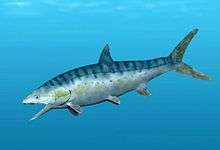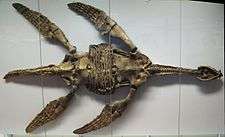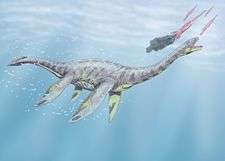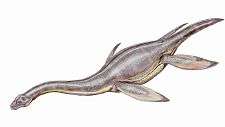Paleobiota of the Posidonia Shale
The Posidonia Shale or Posidonienschiefer Formation is a geological formation of southwestern Germany, northern Switzerland, western Czech Republic, northwestern Austria, southeast Luxembourg and the Netherlands, that spans about 3 million years during the Early Jurassic period (early Toarcian stage). It is known for its detailed fossils, especially sea fauna, listed below.[1] Composed mostly by black shale, the formation is a Lagerstätte, where fossils show exceptional preservation (Including exquisite soft tissues), with a thickness that varies from about 1 m to about 40 m on the Rhine level, being on the main quarry at Holzmaden between 5 and 14 m.[1] Some of the preserved material has been transformed into fossil hydrocarbon Jet, specially wood remains, used for jewelry.[2] The exceptional preservation seen on the Posidonia Shale has been studied since the late 1800s, finding that a cocktail of chemical and environmental factors let to such an impressive conservation of the marine fauna.[2] The most common theory is the changes on the oxygen level, where the different anoxic events of the Toarcian left oxygen-depleted bottom waters, with the biota dying and falling to the bottom without any predator able to eat the dead bodies.[3]
.jpg)
| Part of a series on |
| Paleontology |
|---|
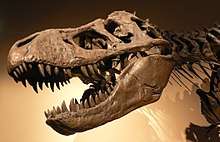 |
|
Fossils
|
|
Natural history |
|
Organs and processes
|
|
Evolution
|
|
History of paleontology |
|
Branches of paleontology |
|
Paleontology Portal Category |
Invertebrata
Ichnofossils
| Genus | Species | Location | Material | Notes | Images |
|---|---|---|---|---|---|
|
|
Burrowing and track ichnofossils |
Burrow-like ichnofossils, that can be related to Crustaceans, Annelids and Fishes.[52] The presence of this burrows changed along the different depositional layers, interpreted as result of relative magnitudes and durations of a series oxygenation events.[52] Increased Oxygen conditions eventually led to a level that permitted both the survival of larger Chondrites and Thalassinoides producing organisms, as well the depth of the Burrow-like structures.[52] The changes on the layers are detailed enough to know that oxygenation-change events duration was sufficient to allowe the migration and establishment of trace-producing organisms, establishing an "equilibrium" with bottom-water oxygen conditions.[52] |
 Thalassinoides found on the Posidonia Shale. | |
|
|
Burrowing and track ichnofossils |
Burrow-like ichnofossils. Interpreted as the feeding burrow of a sediment-ingesting animal.[54] A more recent study has find that Scoloplos armiger and Heteromastus filiformis, occurring in the German Wadden Sea in the lower parts of tidal flats, make burrows that are homonymous with numerous trace fossils of the ichnogenus.[55] |
Illustration of Chondrites bollensis | |
|
Phymatoderma[56] |
|
|
Burrowing and track ichnofossils. |
Burrow-like ichnofossils. It consists commonly on a subhorizontal branching burrow system consisting of radiating tunnels filled with fecal pellets.[56] It has been interpreted as a product made by an Endobenthic deposit-feeding animal, specially a Fodinichnia, burrows produced by benthonic subsurface food-mining activity, as is proved by the tunnels and pelletal infill.[56] The study of the Fecal Pellets has revelated that the maker of this ichnogenus was an epicontinental shelf setting non-selective deposit feeder, ingesting particles on the sediment surface without selection. A mode of feeding common on aquatic Benthos, reported on modern animals such as Spionid Polychaete worms, tropical Holothurians and Spatangoid urchins.[57] |
|
|
|
Burrowing and track ichnofossils.[59] |
Burrow-like ichnofossils. It has been related to Echiuran annelids,[60] but also from moving and feeding polychaete worms.[61] |
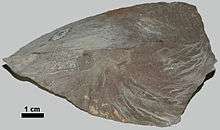 Example of Zoophycos fossil | |
|
Fucoides[62] |
|
|
Burrowing and track ichnofossils. |
Burrow-like ichnofossils. Considered an "Algae incertae sedis" fossil, it was recovered subdivided into 16 different groups, being in 1880 along certain ichnofossil genera, such as Cruziana with a massive nomenclatural complexity. Considered now a feeding burrow of a sediment-ingesting animal, sometimes synonymized with Chondrites. |
|
|
|
Burrowing and track ichnofossils. |
Burrow-like ichnofossils. It is controversial, since is considered a strictly a junior synonym of Palaeophycus.[64] |
 Example of Planolites fossil | |
|
Palaeophycus[65] |
|
|
Burrowing and track ichnofossils. |
Burrow-like ichnofossils. Palaeophycus is considered related with Planolites, being a litoral fodichnia, probably from a Priapulidan. |
Example of Palaeophycus fossil |
|
|
Burrowing and track ichnofossils. |
Burrow-like ichnofossils. It is interpreted as a grazing trail or Fodinichnia, produced at shallow depth in sediment by Polychaetes and Priapulids.[65] |
Example of Helminthopsis fossil | |
|
Gyrochorte[65] |
|
|
Burrowing and track ichnofossils. |
Burrow-like ichnofossils. Gyrochorte is interpreted as a result of active digging on the sediment by deposit-feeding worm-like animal, probably an Annelid or similar kinds of creatures, such as Crustaceans, Sea Urchins, nearshore fishes, etc. |
|
|
Cylindrichnus[65] |
|
|
Burrowing and track ichnofossils. |
Burrow-like ichnofossils. Cylindrichnus isp. was found only on seashore-related sections, and probably represents litoral Polychaete Burrows.[66] |
|
|
|
Burrowing and track ichnofossils. |
Burrow-like ichnofossils. Vertical or oblique complex trace fossil composed of a bunch of spindle-shaped structures and associated tubes, typical of a restricted environment (?estuarine/lagoonal). |
||
|
Spongeliomorpha[65] |
|
|
Burrows and associated traces |
Burrow-like ichnofossils. Spongeliomorpha is believed to come from the domicile of Crustaceans: Anomuras (Probably Eocarcinoidea) and Decapodans (Probably Glypheidae), created as they dig in a firm, semiconsolidated substrate. |
|
|
|
Burrows and associated traces |
Burrow-like ichnofossils. Most Diplocraterion show only protrusive spreit, like the local ones, produced under predominantly erosive conditions where the organism was constantly burrowing deeper into the substrate as sediment was eroded from the top. It can be Made by Crustaceans, Annelids or other benthic fauna.[65] |
 Diplocraterion parallelum diagram | |
Anthozoa
| Genus | Species | Location | Material | Notes | Images |
|---|---|---|---|---|---|
|
|
Polyps |
A stone cora of the family Caryophylliidae inside Hexacorallia. Related to shallow waters, this genus is the main coral found on the Posidonia Shale, resembling the modern Polycyathus muellerae. Its fossils are related with near-land facies, Coralline Islands and relatively small landmases shuch as the Bohemian Massif. |
 Thecocyathus mitrae from Banz | |
Porifera
| Genus | Species | Location | Material | Notes | Images |
|---|---|---|---|---|---|
|
|
Specimens |
A sea sponge of the family Cribrospongiidae inside Sceptrulophora. Found on Shallow and basinal waters, some specimens get 22 cm wide, with a funnel-like morphology. It is relatively common on nearshore strata, but generally rare. |
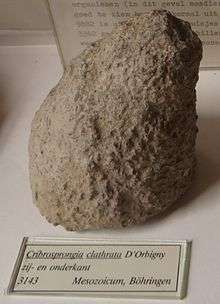 Cribrospongia specimen | |
|
Stauroderma[27] |
|
|
Specimens |
A sea sponge (Glass sponge) of the family Staurodermatidae inside Hexactinellida. Found only on depth Basinal deposits, with a funnel like morphology attaining a diameter of at least 15 cm, with the exception of a large specimen of 30 cm diameter found on Dotternhausen. |
Stauroderma, a 30 cm diameter specimen from Dotternhausen |
Annelida
| Genus | Species | Location | Material | Notes | Images |
|---|---|---|---|---|---|
|
|
Multiple Specimens. |
A sessile, marine annelid tube worm of the family Serpulidae. Its affinities with the genus Serpula are controversial, since the genus is known mostly since Creataceus strata. Although there are other fossils assigned to the genus on same age deposits of France.[69] |
 Head of a modern Serpula vermicularis | |
|
|
Multiple Specimens. |
A sessile, marine annelid tube worm of the family Serpulidae |
||
|
Tetraserpula[72] |
|
|
Multiple Specimens. |
A sessile, marine annelid tube worm of the family Serpulidae. |
|
|
|
Multiple Specimens. |
A sessile, marine annelid tube worm of the family Serpulidae. It show the characteristic features to live on soft mud ground. |
||
|
|
Multiple Specimens. |
A sessile, marine annelid tube worm of the family Serpulidae. It show the characteristic features to live on soft mud ground. |
||
|
|
Multiple Specimens. |
A sessile, marine annelid tube worm of the family Serpulidae. Pentaditrupa managed to lie freely on the mud, as shows that its tube's curvature provides stability to its position. |
||
|
|
Multiple Specimens. |
A sessile, marine annelid tube worm of the family Serpulidae. Denominated "Serpula" segmentata, it lacks the two longitudinal edges characteristic on Mucroserpula. |
||
|
|
Multiple Specimens. |
A polychaete worm of the family Sabellidae. |
 Example of Glomerula specimen | |
|
Dictyothylakos[77] |
|
|
Leech cocoons |
Hirudinea cocoons, identified with palynological residues. The cocoons Dictyothylakos are common on flooded basin sediments, and implies not only the presence of parasitic leeches, but also the presence of large hosts nearby. |
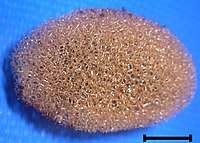 Example of Leech Cocoon |
Mollusca
Bivalvia
| Genus | Species | Location | Material | Notes | Images |
|---|---|---|---|---|---|
|
|
Thousands of Specimens. |
An oxytomid scallop. |
 Colony of specimens | |
|
|
Thousands of Specimens. |
An oxytomid scallop. |
||
|
|
Thousands of Specimens. |
A pectinoid scallop. |
 Single specimen | |
|
|
Thousands of Specimens. |
A pectinoid scallop. |
||
|
|
Thousands of Specimens. |
A propeamussiid mud scallop. |
 Various specimens on the same rock | |
|
|
Thousands of Specimens. |
A plicatulid mud scallop. |
||
|
|
20.000 specimens/m2 |
A "posidoniid" ostreoidan. It is the type fossil of the Posidonia Shale. Originally it was named "Posidonia bronni", thought to be a new genus, and the strata was denominated the Posidonia layers after it. Years later it turned out to be a junior synonym of Bositra, and thus, it was reassigned. However, the name of the layers was retained. The habitat and mode of life of Bositra has been debated for more than a century. There have been different interpretations, such as a pseudoplanktonic organism,[85] a benthic organism[86] related to open marine floor, where it was the main inhabitant of the basinal settings,[87][88] a free swimming mode of life filtering phytoplankton,[84] and a hybrid mode, where it has a life cycle with holopelagic reproduction controlled by the change on Oxygen levels,[89] and even a chemosymbiotic lifestile, related to the large crinoid rafts, being the main "Safe conduct" to evade anoxic events.[90] All the opinions along the years led to a large study in 1998, where the size/frequency distribution, the density of growth thanks to the lines related to the shell size and the position of the redox boundary by total organic carbon diagrams has revealed that Bositra probably had a benthic mode of life.[91] |
 Thousands of specimens in one matrix | |
|
|
Thousands of Specimens. |
A "posidoniid" ostreoidan. Another Genera mistaken with "Posidonia bronni". |
 Various specimens in one matrix | |
|
|
Thousands of Specimens. |
A bakevelliid mud oyster. |
||
|
|
Thousands of Specimens. |
Various specimens | ||
|
|
Thousands of Specimens. |
 Various specimens | ||
|
|
Thousands of Specimens. |
An inoceramid clam. Being the second most common genera of Bivalve on the Formation, it had been object to several studies to find its ecological niche, like Bositra. Several opinions include a pseudoplanktonic-only organism, able to live in open sea,[88] or a benthonic-only organism.[87] On the 1998 evaluation with Bositra, was found that probably has a benthic early life that translated to a faculatively pseudoplanktonic mode of adult life.[91] |
 Single specimen | |
|
|
Thousands of Specimens. |
|||
|
|
Thousands of Specimens. |
|||
|
|
Thousands of Specimens. |
A cucullaeid clam. |
||
|
|
Thousands of Specimens. |
|||
|
|
Thousands of Specimens. |
A pholadomyid clam. |
||
|
|
Thousands of Specimens. |
A mactromyid clam. |
||
|
|
Thousands of Specimens. |
A pleuromyid clam. |
 Pleuromya uniformis, two specimens | |
|
|
Thousands of Specimens. |
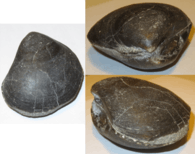 Plagiostoma giganteum, specimen multiview | ||
|
|
Thousands of Specimens. |
A pennospiriferinid rhynchonellatan. |
||
Gastropoda
| Genus | Species | Location | Material | Notes | Images |
|---|---|---|---|---|---|
|
|
Docens of Specimens. |
A Coelodiscidae sea Snail. The is the oldest known holoplanktonic gastropod, thanks to a bilateral symmetrical shells as an adaption to active swimming. Also the most common of the sea snails of the Formation, it is also one of the most varied in size terms, with some of the biggest specimens of snail from the Lower Toarcian know.[92] It has been related to large floating driftwood as one of the primary settlers.[92] |
||
|
Tatediscus[93] |
|
|
Docens of Specimens. |
A Coelodiscidae sea Snail. Possible holoplanktonic gastropod.[92] |
|
|
|
Docens of Specimens. |
A Procerithiidae sea Snail. |
||
|
Toarctocera[94] |
|
|
Docens of Specimens. |
An Aporrhaidae sea Snail. Among the latest described from the formation, is one of the earliest certain aporrhaidae. Characterised by large spines growing at the head of the cunch. |
|
|
|
Docens of Specimens. |
A Cryptaulacidae sea Snail. |
||
|
|
Docens of Specimens. |
A Neritariidae sea Snail. |
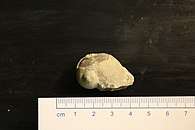 Single specimen | |
|
|
Docens of Specimens. |
A Zygopleuridae sea Snail. |
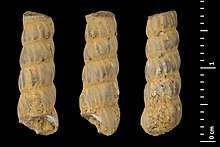 Specimens | |
|
|
Docens of Specimens. |
A Zygopleuridae sea Snail. |
||
|
|
Docens of Specimens. |
 Specimens | ||
|
|
Docens of Specimens. |
A Trochidae sea Snail. Characterised by a rhomboid scaly pattern on the teleoconch whorls. |
||
|
|
Docens of Specimens. |
A Pleurotomariidae sea Snail. |
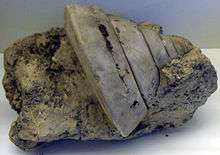 Specimen | |
|
|
Docens of Specimens. |
An Eotomariidae sea Snail. |
||
|
|
Various specimens. |
A Pterotracheidae sea Slug. Among the oldest pelagic floating Slugs, Pterotrachea liassica had a more extended larval period than modern extant Pterotrachea coronata, because one additional whorl is Present.[95] |
Modern Specimen | |
Cephalopoda
| Genus | Species | Location | Material | Notes | Images |
|---|---|---|---|---|---|
|
|
Multiple Specimens. |
A Nautilidae Nautilidan. Includes the largest specimen of Cenoceras known, with 80 cm width. |
 Nautilidae shell from Banz, probably Cenoceras | |
|
|
Multiple Specimens. |
A Lytoceratidae Ammonite. Lytoceras can get quite big, with nearly 50 cm in diameter. |
||
|
|
Multiple Specimens. |
|||
|
|
Multiple Specimens. |
|||
|
|
Multiple Specimens. |
| ||
|
|
Multiple Specimens. |
 Grammoceras specimen from Banz | ||
|
|
Multiple Specimens. |
|||
|
Pseudogrammoceras[100] |
|
|
Multiple Specimens. |
||
|
Hudlestonia[97] |
|
|
Multiple Specimens. |
||
|
Catulloceras[97] |
|
|
Multiple Specimens. |
||
|
|
Multiple Specimens. |
|||
|
Cotteswoldia[97] |
|
|
Multiple Specimens. |
||
|
|
Multiple Specimens. |
 Harpoceras specimen | ||
|
|
Multiple Specimens. |
Tiltoniceras specimen | ||
|
|
Multiple Specimens. |
Hildoceras specimen | ||
|
|
Multiple Specimens. |
 Mercaticeras specimen | ||
|
Eleganticeras[103] |
|
|
Multiple Specimens. |
||
|
|
Multiple Specimens. |
|||
|
|
Multiple Specimens. |
 Dactylioceras commune on Holzmaden | ||
|
|
Multiple Specimens. |
|||
|
|
Multiple Specimens. |
Type Coeloceratidae Ammonite. |
||
|
|
Multiple Specimens. |
A Phylloceratidae Ammonite. The largest ammonite found in the Posidonienschiefer comes from the Ohmden quarry,and belongs to a Phylloceras heterophyllum with a diameter of 87 cm.[103] |
 Phylloceras restoration | |
|
|
Multiple Specimens. |
A Phymatoceratidae Ammonite. |
||
|
|
Multiple Specimens. |
A Phymatoceratidae Ammonite. |
||
|
|
Multiple Specimens. |
A Phymatoceratidae Ammonite. |
||
|
Loligosepia[107] |
|
|
Multiple Specimens. |
A Loligosepiidae Loligosepiidan.[108] The Loligosepiidae is believed to be ancestral to the Recent vampire squid, Vampyroteuthis infernalis.[109] |
Loligosepia Holzmaden specimen |
|
Jeletzkyteuthis[110] |
|
|
Multiple Specimens. |
A Loligosepiidae Loligosepiidan. Related to the modern Vampyroteuthis infernalis. |
|
|
Geopeltis[111] |
|
|
Multiple Specimens. |
A Loligosepiidae Loligosepiidan. Related to the modern Vampyroteuthis infernalis. |
 Geopeltis specimen |
|
Parabelopeltis[112] |
|
|
Multiple Specimens. |
A Loligosepiidae Loligosepiidan. Related to the modern Vampyroteuthis infernalis. |
|
|
Chitinobelus[113] |
|
|
Multiple Specimens. |
A Belemnotheutidae Belemnite. Chitinobelus is an extrange fossil, sice the rostrum was composed of aragonite with organic material, while normal Belemnites had calcite. Has been suggested this rostrum was calcitic. |
|
|
|
Multiple Specimens. |
A Belemnotheutidae Belemnite. |
||
|
|
Multiple Specimens. |
A Belemnotheutidae Belemnite. |
||
|
|
Multiple Specimens. |
A Megateuthididae Belemnite. Includes some of the Biggest Know Belemnites, with stimated maximum up to 4.5 m long in life, altrougth, most specimens would have been rather smaller. |
||
|
|
Multiple Specimens. |
A Megateuthididae Belemnite. |
||
|
|
Multiple Specimens. |
A Megateuthididae Belemnite. Includes really large specimens |
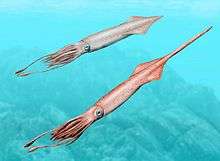 Youngibelus Reconstruction | |
|
|
Multiple Specimens. |
A Passaloteuthididae Belemnite. |
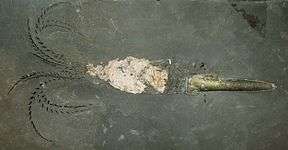 Passaloteuthis Holzmaden specimen | |
|
|
Multiple Specimens. |
A Salpingoteuthididae Belemnite. |
Salpingoteuthis specimen | |
|
Clarkeiteuthis[119] |
|
|
Multiple Specimens. |
A Diplobelidae Coleoidean. It has been found adult individuals of Clarkeiteuthis which caught small teleost fish of the species Leptolepis bronni. Further indirect evidence for the hunting behaviour comes from their body orientation in the water during life.[120] |
Clarkeiteuthis Holzmaden specimen |
|
Lioteuthis[121] |
|
|
Various Specimens. |
Type member of the Lioteuthididae Squid family. The taxonomic position of Lioteuthis is uncertain, although the wings reaching the proximal gladius section and the smooth median field suggest affinity to the Prototeuthididae[121] |
|
|
|
Various Specimens. |
A Teudopseina Squid. |
 Teudopsis Ohmden specimen | |
|
Geotheutis[123] |
|
|
Various Specimens. |
A possible primigenial Cuttlefish. Is one of the most important fossils of Cephalopods on the Posidonia Shale, due to be one of the Earliest examples of Pigments found on any species, also one of the first historically.[124] The pigments are preserved on various specimens with Eumelanin related to its ink sacs and include even phosphatized musculature.[125] |
|
Arthropoda
Cycloidea
| Genus | Species | Location | Material | Notes | Images |
|---|---|---|---|---|---|
|
|
Partial Specimens. |
The First Cycloid Arthropod from the Jurassic, from the family Cycloidae inside Cycloidea.[126] Cycloids are a group of maxillopod arthropods that span between the Paleozoic until the latest Cretaceous, probably related to the crustaceans and probably detritivores.[126] |
||
Malacostraca
| Genus | Species | Location | Material | Notes | Images |
|---|---|---|---|---|---|
|
Orhomalus[127] |
|
|
Partial Specimens. |
A hermit crab of the family Paguroidea. Hermit crabs are common of the marine layers of the lower Jurassic Europe, mostly on the Pliensbachian-Toarcian Boundary of France and Germany. Orthomalus is a small sized crab, probably inhabitant of nearshore waters, and even deltaic and beach environments, similar to modern genera. |
|
|
|
Single Specimen inside an Ammonite Shell. |
An hermit crab of the family Paguridae. |
||
|
|
Nearly complete & Partial Specimens. |
An Astacidea Decapodan of the family Uncinidae. Reaching large sizes of almost half a meter (39–47 cm), Uncina Posidoniae is among the largest know Jurassic Crustaceans. Uncina posidoniae is also the largest representative of the genus Uncina.[130] This large crustacean has been found associated with Ammonite and Bivalve filled Bentos, where probably hunted different kinds of prey.[130] Its large claws would have been perfect for hunt small invertebrates and vertebrates.[130] |
 Uncina posidoniae specimen The Largest complete Uncina posidoniae specimen, with 44 cm long. | |
|
Tonneleryon[131] |
|
|
Partial Specimens and complete Specimens |
A gregarious Polychelidan Lobster. |
|
|
Partial Specimens. |
A Coleiidae Decapodan. The largest Coeloid from the formation, P. giganteus is a species reaching a larger size than most other polychelidans, with up to 15 cm. On the Posidonia Shale there is the most abundant variety of species from the genus, ranging from different sizes and morphologies, that indicate different habitat & feeding adaptations on the genus. Some like P. hartmani show less adaptations to hunt for small nectobenthic preys than other relatives, being abundant on Oyster-filled waters. There is a relatively abundance of the genus in deep-water settings from the Toarcian onward.[137] |
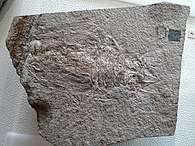 Proeryon hartmanni specimen from Banz Proeryon sp. specimen from Schandelah | ||
|
|
Partial Specimens. |
A Penaeidae Decapodan. |
Antrimpos specimen | |
|
|
Partial Specimens. |
A Erymidae Decapodan. |
Palaeastacus specimen | |
|
|
Complete Specimens. Includes specimens inside ammonites shells |
An Erymidae Decapodan. |
||
|
|
Complete Specimens |
Type genus of the Erymidae Decapodan family. Originally, was named Glyphea amalthei,informally used by Quenstedt and housed on the Museum Naturkunde in Württemberg. A series of posterior revisions probe it was a different genus.[146] |
Eryma specimen | |
|
|
Complete Specimens |
An Erymidae Decapodan. |
||
|
|
Single complete specimen in late larval stage |
The specimen reported represents the oldest fossil record of an achelatan lobster larva, and the first representative of achelatan lobsters in the Posidinia Shale. Shares similarities with the late jurassic genus Cancrinos. |
California spiny lobsters are relatives of the Larval specimen from the Posidonia Shale | |
|
|
Single Incomplete Specimen |
A Stomatopoda Malacostracan. Its affinities haven't been tested. |
 A female Odontodactylus Scyllarus mantis shrimp, maybe related to the Posidonia Specimen | |
Thoracica
| Genus | Species | Location | Material | Notes | Images |
|---|---|---|---|---|---|
|
Toarcolepas[151] |
|
|
Numerous disarticulated individuals, associated with fossil wood.[151] |
A phospatic-shelled Cirripede of the family Eolepadidae.[151] Toarcolepas is provisionally interpreted as the oldest epiplanktonic cirripede known, and is thought to have lived attached to floating driftwood.[151] |
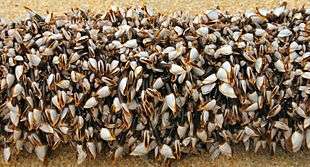 Modern genus Lepas is the most related taxa to Toarcolepas |
Arachnida
| Genus | Species | Location | Material | Notes | Images |
|---|---|---|---|---|---|
|
|
Single Incomplete Specimen. |
Being the only Jurassic scorpion known, there is no evidence that L. schmidti was aquatic (which was suggested in the past) and in the absence of further, better preserved material it should be excluded from future considerations of broad patterns of scorpion evolution.[153] |
.jpg) Speculative Reconstruction | |
Insecta
Insects are a common terrestrial animals that where proabaly drifted to the sea due to Moonsonal conditions present on the Posidonia Shale.[154]
| Genus | Species | Location | Material | Notes | Images |
|---|---|---|---|---|---|
|
|
Specimens |
A Dragonfly of the family Heterophlebiidae. A relative abundant genus, present on most of the pits of the Posidonia Shale, even on Holzmaden. |
||
|
Plagiophlebia[156] |
|
|
Specimens |
A Dragonfly of the family Heterophlebiidae. |
|
|
Heterothemis[157] |
|
|
Specimens |
A Dragonfly of the family Liassogomphidae. Second most abundant genus of Odonatan in the Formation. |
|
|
|
Specimens |
A Dragonfly of the family Liassogomphidae. |
||
|
Proinogomphus[156] |
|
|
Specimens |
A Dragonfly of the family Liassogomphidae. |
|
|
Ensphingophlebia[156] |
|
|
Specimens |
A Dragonfly of the family Sphenophlebiidae. |
|
|
Mesoepiophlebia[159] |
|
|
Specimens |
A Dragonfly of the family Sphenophlebiidae. |
|
|
Liassostenophlebia[156] |
|
|
Specimens |
||
|
Syrrhoe[156] |
|
|
Specimens |
A Dragonfly. |
|
|
Strongylogomphus[156] |
|
|
Specimens |
A Dragonfly. |
|
|
|
Specimens |
A Dragonfly of the family Myopophlebiidae. |
||
|
|
Specimens |
A Dragonfly of the family Myopophlebiidae. |
||
|
Paraplagiophlebia[159] |
|
|
Specimens |
A Dragonfly of the family Myopophlebiidae. |
|
|
|
Specimens |
A Dragonfly of the Family Liassogomphidae. |
||
|
|
Specimens |
A Dragonfly of the family Campterophlebiidae.The largest Early Jurassic Insect Know, with a wings size up to 20 cm.[162] |
||
|
Gallodorsettia[163] |
|
|
Specimens |
A Dragonfly of the family Campterophlebiidae. |
|
|
Henrotayia[164] |
|
|
Specimens |
A Dragonfly of the family Henrotayiidae. |
|
|
Liadoblattina[165] |
|
|
Specimens |
A Cockroach of the family Raphidiomimidae. |
|
|
Ptyctoblattina[156] |
|
|
Specimens |
A Cockroach of the family Raphidiomimidae. |
|
|
Caloblattina[156] |
|
|
Specimens |
A Cockroach of the family Caloblattinidae. |
|
|
Blattula[156] |
|
|
Specimens |
A Cockroach of the family Blattulidae. |
|
|
|
Specimens |
A Stick insect. One of the described insects found more near the Bohemian Massif, where probably belong most of the terrestrial invertebrate fauna. |
||
|
Chresmodella |
|
|
Specimens |
A Stick insect of the family Aerophasmidae. |
|
|
Compactofulgoridium[156] |
|
|
Specimens |
A Grasshopper. |
|
|
Protogryllus[156] |
|
|
Specimens |
A Grasshopper of the family Protogryllidae. |
|
|
Panorpidium[156] |
|
|
Specimens |
A Grasshopper of the family Elcanidae. |
|
|
Acridiopsis[156] |
|
|
Specimens |
A Short-horned Grasshopper of the family Acrididae. |
|
|
Locustopsis[156] |
|
|
Specimens |
A Grasshopper of the family Locustopsidae. |
|
|
Liadolocusta[156] |
|
|
Specimens |
A Grasshopper of the family Locustopsidae. |
|
|
Archijassus[156] |
|
|
Specimens |
A Planthopper of the family Archijassidae. |
|
|
Elasmoscelidium[156] |
|
|
Specimens |
A Planthopper. |
|
|
Fulgoridium[156] |
|
|
Specimens |
A Planthopper of the family Fulgoridiidae. |
|
|
Fulgoridulum[156] |
|
|
Specimens |
A Planthopper of the family Fulgoridiidae. |
|
|
Procerofulgoridium[156] |
|
|
Specimens |
A Planthopper of the family Fulgoridiidae. |
|
|
Tetrafulgoria[156] |
|
|
Specimens |
A Planthopper of the family Fulgoridiidae. |
|
|
Metafulgoridium[156] |
|
|
Specimens |
A Planthopper of the family Fulgoridiidae. |
|
|
Productofulgoridium[156] |
|
|
Specimens |
A Planthopper of the family Fulgoridiidae. |
|
|
Margaroptilon[156] |
|
|
Specimens |
A Planthopper of the family Fulgoridiidae. |
|
|
Compactofulgoridium[156] |
|
|
Specimens |
A Planthopper of the family Fulgoridiidae. |
|
|
Procercopis[156] |
|
|
Specimens |
A Froghopper of the family Procercopidae. |
|
|
Megalocoris[156] |
|
|
Specimens |
A Shore bug. |
|
|
Eurynotis[156] |
|
|
Specimens |
A Shore bug of the family Archegocimicidae. |
|
|
Somatocoris[156] |
|
|
Specimens |
A Shore bug of the family Archegocimicidae. |
|
|
Corynecoris[156] |
|
|
Specimens |
A Shore bug of the family Archegocimicidae. |
|
|
Entomecoris[156] |
|
|
Specimens |
A Shore bug of the family Archegocimicidae. |
|
|
Ensphingocoris[156] |
|
|
Specimens |
A Shore bug of the family Archegocimicidae. |
|
|
Engynabis[156] |
|
|
Specimens |
A Shore bug of the family Archegocimicidae. |
|
|
Apicasia[156] |
|
|
Specimens |
A basal Beetle. |
|
|
Pholipheron[156] |
|
|
Specimens |
A basal Beetle. |
|
|
Grasselites[156] |
|
|
Specimens |
A basal Beetle. |
|
|
Omogongylus[156] |
|
|
Specimens |
A basal Beetle. |
|
|
Sideriosemion[156] |
|
|
Specimens |
A basal Beetle. |
|
|
Metanastes[156] |
|
|
Specimens |
A basal Beetle. |
|
|
Diatrypamene[156] |
|
|
Specimens |
A basal Beetle. |
|
|
Aptilotitus[156] |
|
|
Specimens |
A basal Beetle. |
|
|
Rhomaleus[156] |
|
|
Specimens |
A basal Beetle. |
|
|
Leptosolenophorus[156] |
|
|
Specimens |
A basal Beetle. |
|
|
Gastroratus[156] |
|
|
Specimens |
A basal Beetle. |
|
|
Brachylaimon[156] |
|
|
Specimens |
A basal Beetle. |
|
|
Pleuralocista[156] |
|
|
Specimens |
A basal Beetle. |
|
|
Mesoncus[156] |
|
|
Specimens |
A basal Beetle. |
|
|
Palaeotrachys[156] |
|
|
Specimens |
A basal Beetle. |
|
|
Hydroicetes[156] |
|
|
Specimens |
A basal Beetle. |
|
|
Scalopoides[156] |
|
|
Specimens |
A basal Beetle. |
|
|
Peridosoma[156] |
|
|
Specimens |
A basal Beetle. |
|
|
|
Specimens |
A basal Beetle. |
||
|
Sphaerocantharis[156] |
|
|
Specimens |
A basal Beetle. |
|
|
Rhysopsalis[156] |
|
|
Specimens |
A basal Beetle. |
|
|
Diplocelides[156] |
|
|
Specimens |
A basal Beetle. |
|
|
Tripsalis[156] |
|
|
Specimens |
A basal Beetle. |
|
|
Trochiscites[156] |
|
|
Specimens |
A basal Beetle. |
|
|
Prosynactus[156] |
|
|
Specimens |
A False Ground Beetle of the family Trachypachidae. |
|
|
Coreoeicos[156] |
|
|
Specimens |
A False Ground Beetle of the family Trachypachidae. |
|
|
Aposphinctus[156] |
|
|
Specimens |
A Water Scavenger Beetle of the family Hydrophilidae. |
|
|
Zetemenos[156] |
|
|
Specimens |
A basal Beetle. |
|
|
Amphoxyne[156] |
|
|
Specimens |
A basal Beetle. |
|
|
|
Specimens |
A basal Beetle. |
||
|
Amblycephalonius[156] |
|
|
Specimens |
A basal Beetle of the family Coptoclavidae. |
|
|
Ooperioristus[156] |
|
|
Specimens |
A basal Beetle of the family Coptoclavidae. |
|
|
Camaricopterus[156] |
|
|
Specimens |
A basal Beetle of the family Schizophoridae. |
|
|
Megachorites[156] |
|
|
Specimens |
A Giant Beetle. It is among the largest found on all the Jurassic. |
|
|
Protobittacus[156] |
|
|
Specimens |
A Hangingfly of the family Bittacidae. |
|
|
Parabittacus[156] |
|
|
Specimens |
A Hangingfly of the family Bittacidae. |
|
|
Haplobittacus[156] |
|
|
Specimens |
A Hangingfly of the family Bittacidae. |
|
|
Mesobittacus[156] |
|
|
Specimens |
A Hangingfly of the family Bittacidae. |
|
|
Orthophlebia[156] |
|
|
Specimens |
A Scorpionfly of the family Orthophlebiidae. |
|
|
Parorthophlebia[156] |
|
|
Specimens |
A Scorpionfly of the family Orthophlebiidae. |
|
|
Mesopanorpa[156] |
|
|
Specimens |
A Scorpionfly of the family Orthophlebiidae. |
|
|
Pseudopolycentropus[156] |
|
|
Specimens |
A Scorpionfly of the family Pseudopolycentropodidae. |
|
|
Homoeoptychopteris[156] |
|
|
Specimens |
A Fly. |
|
|
Amianta[156] |
|
|
Specimens |
A Fly. |
|
|
Culiciscolex[156] |
|
|
Specimens |
A Fly. |
|
|
Liassonympha[156] |
|
|
Specimens |
A Fly. |
|
|
Bodephora[156] |
|
|
Specimens |
A Fly. |
|
|
Apistogrypotes[156] |
|
|
Specimens |
A Fly. |
|
|
Amphipromeca[156] |
|
|
Specimens |
A Fly. |
|
|
Cyrtomides[156] |
|
|
Specimens |
A Fly. |
|
|
Sphallonymphites[156] |
|
|
Specimens |
A Fly. |
|
|
Propexis[156] |
|
|
Specimens |
A Fly. |
|
|
Archipleciomima[169] |
|
|
Specimens |
A Fly. |
|
|
Protoplecia[156] |
|
|
Specimens |
A Fly of the family Protopleciidae. |
|
|
Mesorhyphus[169] |
|
|
Specimens |
A Wood Gnat of the family Anisopodidae. |
|
|
Metaraphidia[156] |
|
|
Specimens |
A Snakefly. |
|
|
Heterorhyphus[156] |
|
|
Specimens |
A Fly. |
|
|
Amblylexis[156] |
|
|
Specimens |
A Fly. |
|
|
Ellipibodus[156] |
|
|
Specimens |
A Fly. |
|
|
Homoeoptychopteris[156] |
|
|
Specimens |
A Fly. |
|
|
Protorhyphus[156] |
|
|
Specimens |
A Fly of the family Protorhyphidae. |
|
|
Praemacrochile[156] |
|
|
Specimens |
A primitive Crane fly of the family Tanyderidae. |
|
|
|
Specimens |
A primitive Crane fly of the family Tanyderidae. |
||
|
Architipula[156] |
|
|
Specimens |
A Crane fly of the family Limoniidae. |
|
|
Ozotipula[156] |
|
|
Specimens |
A Crane fly of the family Limoniidae. |
|
|
Haplotipula[156] |
|
|
Specimens |
A Crane fly of the family Limoniidae. |
|
|
Leptotipuloides[156] |
|
|
Specimens |
A Crane fly. |
|
|
Mikrotipula[156] |
|
|
Specimens |
A Crane fly. |
|
|
|
Specimens |
A Phantom Crane fly of the family Ptychopteridae. |
||
|
|
Specimens |
A Caddisfly. |
||
|
|
Specimens |
A Lacewing of the family Prohemerobiidae. |
||
|
Parhemerobius[156] |
|
|
Specimens |
A Lacewing of the family Prohemerobiidae. |
|
|
Paractinophlebia[156] |
|
|
Specimens |
A Lacewing of the family Prohemerobiidae. |
|
|
Liassopsychops[156] |
|
|
Specimens |
A Lacewing of the family Prohemerobiidae. |
|
|
Tetanoptilon[156] |
|
|
Specimens |
||
|
Protoaristenymphes[173] |
|
|
Specimens |
A lance Lacewing of the family Mesochrysopidae. |
|
|
|
Specimens |
A Hairy Cicada of the family Tettigarctidae. |
||
|
Liassotettigarcta[167] |
|
|
Specimens |
A Hairy Cicada of the family Tettigarctidae. |
|
|
Xulsigia[175] |
|
|
Specimens |
A Sternorrhynchan of the family Pincombeomorpha. It is curious for its peculiar venation on its wings. Has been proposed its own family, Xulsigiidae. |
|
|
Indutionomarus[176] |
|
|
Specimens |
A Coleorrhynchan of the family Progonocimicidae. |
|
|
Thilopterus[156] |
|
|
Specimens |
A Wasp of the family Ephialtitidae. |
|
|
Symphytopterus[156] |
|
|
Specimens |
A Wasp of the family Ephialtitidae. |
|
|
Liadobracona[156] |
|
|
Specimens |
A Wasp of the family Ephialtitidae. |
|
|
Pseudoxyelocerus[177] |
|
|
Specimens |
A Wood Wasp of the family Xyelotomidae. |
|
|
Agmatozoon[156] |
|
|
Specimens |
A non classified Insect. |
|
|
Campeulites[156] |
|
|
Specimens |
A non classified Insect. |
|
|
Tomeferusa[156] |
|
|
Specimens |
A non classified Insect. |
|
|
Trimerocephalium[156] |
|
|
Specimens |
A non classified Insect. |
|
|
Elasmoscolex[156] |
|
|
Specimens |
A non classified Insect. |
|
|
Epimetrophora[156] |
|
|
Specimens |
A non classified Insect. |
|
|
Oocephalina[156] |
|
|
Specimens |
A non classified Insect. |
|
|
Platycorion[156] |
|
|
Specimens |
A non classified Insect. |
|
|
|
Specimens |
A Dicondylian, from the family Protomyrmeleontidae. |
||
|
Dorniella[156] |
|
|
Specimens |
A basal Insect of the family Blattogryllidae. |
|
|
|
Specimens |
A basal Insect of the family Geinitziidae. |
||
|
Adelocoris[156] |
|
|
Specimens |
A basal Insect of the family Pachymeridiidae. |
|
|
Stiphroschema[156] |
|
|
Specimens |
A basal Insect of the family Pachymeridiidae. |
|
Echinodermata
Asterozoa
| Genus | Species | Location | Material | Notes | Images |
|---|---|---|---|---|---|
|
|
Few Specimens. |
An Ophiuridan of the family Ophiactidae. Very rare on the layers. |
_(20395173566).jpg) Modern Specimen | |
|
Mesophiomusium[181] |
|
|
Few Specimens. |
An Ophiuridan of the family Ophiolepididae. Very rare on the layers, being Mesophiomusium geisingense the most common of the two species present. |
|
|
Ophiarachna[181] |
|
|
Various Specimens. |
An Ophiuridan of the family Ophiacanthida. Very Common, related to non anoxic water sedimentation. |
|
|
|
Various Specimens. |
An Ophiuridan of the family Aplocomidae. Very Common. |
_90.3.9802.jpg) Fossil Specimen | |
|
?Ophiura[181] |
|
|
Few Specimens. |
An Ophiuridan of the family Ophiuridae. Its relationships haven't been confirmed and it is based on very fragmentary remains. |
 Appearance |
|
?Ophiocten[181] |
|
|
Few Specimens. |
An Ophiuridan of the family Ophiuridae. Its relationships haven't been confirmed and it is based on very fragmentary remains. |
|
|
|
Few Specimens. |
An Asteroidean of the family Astropectinidae. It is very rare on the layers, and a few fragmentary specimens are known. Only a relatively complete specimen is known from Banz Abbey. |
 Pentasteria sp. from Banz | |
Echinoidea
| Genus | Species | Location | Material | Notes | Images |
|---|---|---|---|---|---|
|
|
Few Specimens. |
A sea urchin of the family Cidaridae. Common on several layers. Cidaris is genus that still alive today. A bottom dweller, is commonly found associated with Belemnnite fossils, probably due to eating its carcasses. |
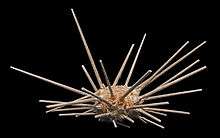 Modern Specimen | |
|
Diademopsis[99] |
|
|
Docens of Specimens |
A sea urchin of the family Pedinidae. It is the most common sea urchin in the formation, present on all the levels with specimens of various sizes. Vinculated to sea bottom sediments, before Gasteropods and Bivalves, Diademospsis was the tird major colonizer of the bottom, in between anoxic changes. |
Specimens from Holzmaden |
|
Procidaris[99] |
|
|
Few Specimens. |
A sea urchin of the family Miocidaridae |
|
Holothuroidea
| Genus | Species | Location | Material | Notes | Images |
|---|---|---|---|---|---|
|
Uncinulina[185] |
|
|
Few Specimens. |
A Sea Cucumber of the Family Elasipodida. Common on the Austrian realm, characterised due to been present of Pelagic environments, as is common on modern genera of its family, but not on the fossil record. Can be the oldest pelagic representative of the Sea Cucumber family. Can be also related to the modern deep sea genus Enypniastes. |
 Modern Species Enypniastes can be related to Uncinulina |
Crinoidea
| Genus | Species | Location | Material | Notes | Images |
|---|---|---|---|---|---|
|
Praetetracrinus[186] |
|
|
Multiple specimens. |
A Crinoidean of the family Plicatocrinidae. |
|
|
Shroshaecrinus[186] |
|
|
Multiple specimens. |
A Crinoidean of the family Millericrinidae. |
|
|
Procomaster[181] |
|
|
Multiple specimens. |
A Crinoidean of the family Isocrinida. |
|
|
Isocrinus[187] |
|
|
Multiple specimens. |
Type genus of Crinoidean of the family Isocrinida. |
 Close view of one specimen  Single specimen |
|
Seirocrinus[40] |
|
|
Multiple specimens. Fossilized rafts of +10 m long with complete colonies. |
The Largest Know Crinoidean, from the family Pentacrinitidae. Among the tallest animals of its period, Seirocrinus is also one of the most famous fossils from the Posidonia Shale. It consists of fossils of colonies along large wood trunks, with specimens up to 14 m long, with the largest specimen reaching 26 m long,[188] what makes it among the tallest know Mesozoic organisms, one of the largest invertebrates know on the fossil record and one of the tallest know animals. It was an open ocean organism that lived in rafting woods, probably filtering food and serving as a refuge for other animals, such as ammonites.[189] The crinoids had a large colonization process, based on the status of the fossil wood found.[190][191] The large rafts where the home for a high variety of marine organisms, such as Balanoideans, Ammonites and other. It has been stimated that without the presence of modern raft wood predators (that apperared on the Bathonian) those rafts can last up to 5 years, being that the main reason the crinoids where able to attach such huge sizes. The large rafts where also proabaly essential to distribute animals along the Early Jurassic Seas.[192] |
_(Posidonia_Shale%2C_Lower_Jurassic%3B_Holzmaden_area%2C_Germany)_1_(35674916591).jpg) Close view of one specimen  Single specimen |
|
|
Multiple specimens. Fossilized rafts of +10 m long with complete colonies. |
Type genus of Crinoidean from the family Pentacrinitidae. Like Seirocrinus, Pentacrinites formed colonies on rafting wood, getting a different role than bigger crinoid and appearing on the first stages of the descomposition of the rafting wood. Was a smaller genus, with specimens of no more than 1 meter long, usually measuring 40–70 cm. |
Close view of one specimen  Reconstruction | |
Vertebrata
Fishes
Chondrichthyes
| Genus | Species | Location | Material | Notes | Images |
|---|---|---|---|---|---|
|
Microtoxodus[195] |
|
|
Teeth |
A non classified Elasmobranch. |
|
|
|
Teeth |
Thype shark of the family Synechodontiformes. |
||
|
Rhomphaiodon[195] |
|
|
Teeth |
A shark of the family Synechodontiformes. |
|
|
|
Teeth |
A member of the family Protospinacidae. |
||
|
Palidiplospinax[197] |
|
|
Articulated vertebral column, girdles, both fin spines and clasper organ |
A member of the family Palaeospinacidae. |
|
|
|
Anterior part of body with basicranium, palatoquadrates, Meckel's cartilage, ceratohyals, epihyals, teeth, traces of the branchial arches and the anterior finspine |
Type member of the family Palaeospinacidae. |
||
|
Mesiteia[195] |
|
|
Teeth |
A Carpet shark of the family Orectolobiformes. |
|
|
|
Teeth |
A Carpet shark of the family Hemiscylliidae. |
 Modern Chiloscyllium | |
|
|
Teeth |
A Carpet shark of the family Orectolobiformes. |
||
|
Ornatoscyllium[104] |
|
|
Teeth |
A Carpet shark of the family Orectolobiformes. |
|
|
|
Teeth |
A Carpet shark of the family Orectolobiformes. |
||
|
|
Teeth |
A Bullhead Shark of the family Heterodontidae. |
||
|
|
Teeth. |
A Bullhead Shark of the family Heterodontidae. |
||
|
Agaleus[195] |
|
|
Teeth |
A shark of the family Agaleidae. |
|
|
|
Teeth |
A shark of the family Acrodontidae. |
||
|
|
Teeth |
A shark of the family Hybodontiformes. |
||
|
Crassodus[200] |
|
|
Meckelian Cartilages, Jaws, teeth, Palatoquadrates, placoid scales and desarticualted parts of the labial, hyoid and branchial skeleton. |
A shark of the family Hybodontidae. The Type specimen belongs to a large hybodontid, with an stimated total length of up to 3 m.[200] It has a Meckelian Cartilage more robust than Hybodus hauffianus and an acrodontine dentition, as seen on Bdellodus.[200] Probably is related with "Hybodus" delabechei, very likely a junior synonym of Crassodus.[200] |
|
|
Bdellodus[201] |
|
|
Teeth. |
A shark of the family Hybodontidae. |
Bdellodus |
|
|
Complete Specimens and fragments, including Teeth, scales, jaws and Cartilage. |
Type shark of the family Hybodontidae. It is the most abundant shark on the layers of the Posidonia Shale, with some of the best preserved specimens of the genus known. It was probably an open ocean hunter, with small horns over the eyes. With a size around 2 m, it was also one of the largest representatives of the Chondrichthyes on the formation.[204][205] |
 Hybodus Holzmaden specimen, among the best preserved of the genus, with Belemmnites inside. Hybodus Another Holzmaden specimen | |
|
Pseudonotidanus[206] |
|
|
Fragmentary and Complete Specimens |
A shark of the family Hexanchiformes. |
|
|
Bathytheristes[207] |
|
|
Partially Complete Specimen, with associated teeth |
A member of Callorhynchidae inside Chimaeriformes. Similar to Callorhinchus, among the oldest known of its type. |
.gif) Callorhinchus milii can be the closest relative of Bathytheristes |
|
Acanthorhina[208] |
|
|
Head and postcranial remains |
A member of Myriacanthidae inside Chimaeriformes. An aberrant Chimaera with an extrange elongated nose and horns over the skull. |
Acanthorhina |
|
|
Head and several postcranial remains |
A member of Myriacanthidae inside Chimaeriformes. An aberrant Chimaera with a second jaw-like structure on its head. |
||
|
|
Teeth |
A Basal member of the Rajiformes of the family Archaeobatidae. |
||
|
|
Teeth |
A Basal member of the Rajiformes of the family Archaeobatidae. |
||
|
Doliobatis[210] |
|
|
Teeth |
A Basal member of the Rajiformes of the family Archaeobatidae. |
|
|
|
Teeth |
A Basal member of the Rajiformes. |
||
Actinopteri
| Genus | Species | Location | Material | Notes | Images |
|---|---|---|---|---|---|
|
Holzmadenfuro[211] |
|
|
Complete Specimen |
First ganoin-scaled Ophiopsiformes (Halecomorphi) from the Posidonienschiefer. The type specimen measures 51 cm, and has elongated and serrated body scales before the dorsal fin and tiny ganoid scales after it.[211] |
|
|
Ohmdenfuro[211] |
|
|
Nearly complete specimen with broken skull |
First ganoin-scaled Ophiopsiformes (Halecomorphi) from the Posidonienschiefer. Elongated morphology, with a length of ~39 cm, covered by smooth, masive ganoin scales.[211] |
|
|
|
Various Complete and nearly complete Specimens |
Type Genus of the family Caturidae inside Amiiformes |
| |
|
|
Multiple specimens. |
The youngest representative of the family Saurichthyidae, known for its large jaws, similar to modern Belonidae. |
| |
|
|
Multiple specimens. |
Type member of the family Ptycholepididae inside Ptycholepiformes. It is one of the Youngest representatives of its Family. |
| |
|
|
Multiple specimens. |
A member of the family Pholidophoridae. Is among the most abundant fishes on the late liassic of Europe, present on the sub-mediterranean boreal, with specimens of several sizes. |
| |
|
Luxembourgichthys[216] |
|
|
Multiple specimens. |
A member of the family Pholidophoridae. |
|
|
|
Multiple specimens. |
A member of the family Leptolepididae. The most common member of its family, Leptolepis is commonly associated with Crustaceans and small marine invertebrates, probably main creatures on its diet. One on the most predated vertebrates on the formation, with abundance of larger fishes and reptiles with specimens associated. |
| |
|
Paraleptolepis[218] |
|
|
MB. f.7612, nearly complete specimen. |
A member of the family Leptolepididae. It differs from Leptolepis coryphaenoides in the presence of a few autapomorphics and also in the retention of several primitive features not present on the last one.[218] Small genus, of about 14 cm length.[218] |
|
|
|
Multiple specimens. |
A member of the family Pachycormidae. |
| |
|
|
Multiple specimens. |
A member of the family Pachycormidae. Large representative of the family, reaching sizes up to 2.3 m. |
| |
|
|
Multiple specimens. |
Type member of the family Pachycormidae. Large representative of its family, with a size up to 1.5 m. One specimen preserved the alimentary canal, with the stomach filled by numerous hooklets that can be referred to the coleoid cephalopod Phragmoteuthis, impliying a diet of cephalopods from this genus.[223] |
| |
|
|
Multiple specimens. |
A large member of the family Pachycormidae. |
| |
|
|
Partial specimen. |
A large member of the family Pachycormidae, with up to 2.5–3 m long and an estimated weight over 200 kg.[226][227] Considered originally a junior synonym of Pachycormus, altrougth the craneal bones suggest a new genus. Among the largest fish found on the formation it is a key fossil on the transition to large filter feeding fishes.[227] Being Coeval with another basal Pachycormiformes show the specialization of the group during the late lower jurassic.[227] Ohmdenia is the sister taxa to group of suspension-feeding Giant Middle-Late Jurassic Fishes (Including the famous Leedsichthys), showing alterations on its dental structure, with jaw indicates a diet based on soft body prey.[227] Its evolutionary significance is equiparable to that of the genus Aetiocetus for the modern Baleen whale.[227] |
| |
|
Multiple specimens. |
A deep-bodied neopterygian, Type member of the family Dapediidae. Unpublished material indicates the presence of one or even two more still undescribed species of Dapedium in the Lower Toarcian.[229] |
| ||
|
|
Multiple specimens. |
A common member of the Lepisosteiformes. |
| |
|
|
Multiple specimens. |
A common member of the Semionotidae. |
| |
|
|
Various Specimens |
A large member of the Chondrosteidae and the largest non reptilian marine vertebrate of the Posidonia shale, with a size between 3 and 4.5 m, and an estimated weight over 800 kg to 1 tonne.[233] Has been suggested as a junior Synonym of Chrondrosteus, altrougth there haven't been any new revision about the status of the genus. It is related to modern sturgeons, but with a different kind of mouth than common species, made for hunting prey in open waters, with a strong lower jaw, similar to modern Beluga Sturgeons.[235] |
| |
Sarcopterygii
| Genus | Species | Location | Material | Notes | Images |
|---|---|---|---|---|---|
|
|
Various Specimens with diverse degree of preservation. |
A large coelacanth of the family Mawsoniidae, related with the genera Axelrodichthys, Chinlea, Diplurus and the type Mawsonia.[237] The largest specimen know from the Posidonia Shale is GPIT.OS.770 (Holotype), with a length over 1.6 m.[236] The specimen presents an ossified lung inside the abdominal cavity, and most of the body, being also one of the most complete Coelacanths of the Jurassic found.[236][237] Some recent discoveries from the Middle Jurassic show specimens of up to 3.5 m long.[238] Trachymetopon precedes the presence of the family Mawsoniidae in Europe by about 120 Ma and the northernmost occurrence of a member of the group, impliying an extensive geographical range during the Early Jurassic.[237] Due to the specimens being found on pelagic deposits suggest that probably was an open ocean swimmer.[236][237] |
Trachymetopon GPIT.OS.770 | |
Reptiles
Ichthyosauria
Inderminate specimens are known.[99]
| Genus | Species | Location | Material | Notes | Images |
|---|---|---|---|---|---|
|
|
Multiple specimens with different degree of preservation. |
Type genus of the family Temnodontosauridae. A large Macroraptorial Ichthyosaur, apex predator of its environment. It range on sizes between the 9 and the 12 m, being one of the largest know ichthyosaurs, characterized by skulls and jaws over 1 m in length, with the largest being over 1.9 m long. It has been found with fragments of young icthyosaur on his stomach.[241] Of 39 specimens of Temnodontosaurus studied, a 21% (8 Specimens) show pathologies along their body, with several injuries post traumatic, probably done by other marine reptiles.[242] |
 Temnodontosaurus hunting Temnodontosaurus trigonodon specimen. | |
|
|
Multiple specimens. Some of them are among the best preserved Ichthyosaur remains known.[243][244][245][246] |
Type genus of the family Stenopterygiidae. A common Toarcian Ichthyosaur, present on multiple layers. The rather exquisite level of preservation has led to know even the coloration, that exposes a clear countershading, with an upper part being more obscure than the lower, similar to modern Killer Whales, the Heaviside's dolphin or the Dall's porpoise. There is also evidence of changes in color with ontogenic chnges, going from dark juveniles to countershaded adults. The skin was flexible & Scaless, as in Dolphins.[247] |
 Restoration  Fossil mother with embryo | |
|
|
Multiple specimens. |
Type genus of the family Suevoleviathanidae. Includes specimens up to 4 m long. |
Suevoleviathan integer fossil | |
|
|
Complete Specimen. |
Small sized Ichthyosaur, probably a member of Parvipelvia.[252] |
Hauffiopteryx typicus fossil | |
|
|
Complete and partial Specimens. |
A large ichthyosaur of the family Leptonectidae with convergent evolution with modern Swordfish. Like this fishes, Eurhinosaurus is believed to be a fast swimming predator, able to hunt fish schools on same way. Large specimens of up to 6 m are known. |
Complete specimen from the Posidonia Shale  Eurhinosaurus restoration | |
Plesiosauria
| Genus | Species | Location | Material | Notes | Images |
|---|---|---|---|---|---|
|
|
Nearly complete specimen. |
A Rhomaleosauridae Plesiosaur. Its detailed fossils have helped to study plesiosaur movement.[257] |
| |
|
|
Complete specimen. |
A Rhomaleosauridae Plesiosaur. A moderately sized (3.4 m) Rhomaleaosaurid, ecologically adapted to fish hunt, as has been observed due to comparing the long snouted skull with that of Peloneustes, Gharial Crocodiles or Dolphins.[258] |
| |
|
|
Complete Specimen. |
A basal Plesiosaur that has been linked with Cryptoclididae. It is one of the smallest from the Posidonia, with a complete skeleton measuring less than 2.5 m. It is considered a possible junior synonym of Seeleyosaurus[261] |
| |
|
|
Complete Specimens. |
A Plesiosaur of the family Microcleididae. It was named originally "Plesiosaurus guilelmiimperatoris". It was a moderate‐sized plesiosauroid, measuring up to 3,5 m in length with a skull length of 170 mm.[263] |
| |
|
|
Several Complete Specimens. |
Type member of the Plesiosaur family Microcleididae. Small Plesiosaur, with a length of less than 3 m. Possible Junior synonym of Hydrorion |
| |
|
|
Complete Specimen. |
A Plesiosaur of the family Plesiosauridae. It is characterised by a really enlongated neck, was probably an ichthyophagous form that occurred rarely in the Posidonienschiefer fauna. |
| |
Sphenodontia
| Genus | Species | Location | Material | Notes | Images |
|---|---|---|---|---|---|
|
|
Complete specimens. |
An aquatic sphenodont of the family Pleurosauridae. Palaeopleurosaurus evidences that there was a slightly skeletal specialization for an aquatic lifestyle, achieved trougth the Jurassic gradually on pleurosaurs.[267] It has similarities with other marine reptiles, such with members of Sauropterygia the presence of a defined suture between the centrum and the neural arch, along with reducted sternum.[268] Probably had a semiaquatic style of life, altrought not as adapted as Pleurosaurus, as show limited morphological evidence of adaptation to a complete aquatic lifestyle, defined by no Osteosclerosis and the lack of Pachyostosis, except for a thicker shaft region in the humerus, that is as narrow as in terrestrial rhynchocephalians, such as the terrestrial Clevosaurus.[268] Palaeopleurosaurus probably was still able to walk on land, for example for Oviposition.[268] Recent studies suggest a shorter lifespan than modern Tuatara, based on irregular spacing of growth marks.[269] |
| |
Testudinata
| Genus | Species | Location | Material | Notes | Images |
|---|---|---|---|---|---|
|
|
Various partial specimens, mostly pleurals. |
Unclassified Testudine. Münster (1834) cited: " there were also rare things at the quarries of Altdorf, among other remains there where ones of a turtle on lias limestone"". The remains are not cataloged.[273] |
||
|
|
Various partial specimens, mostly pleurals. Includes a left partial shell. |
Assigned to Mesochelydia(?) due to resemblances for the authors to modern turtles. Unclassified and non cataloged.[273] |
||
|
|
Fragmentary Remains |
Can be a more basal taxon or even not a turtle. If it is, can be the first Turtle remains found on the Posidonia Shale since the late 1800s. Now on a private collection.[275] |
||
Crocodrylomorpha
| Genus | Species | Location | Material | Notes | Images |
|---|---|---|---|---|---|
|
|
Complete specimens. |
A marine crocodrylomorph with a diet probably based on fish.[277] It is the best known member of the family Teleosauriade. The Genus was declared Invalid in 2020. |
||
|
|
Series of Complete specimens, including skin impressions |
A Thalattosuchian of the family Teleosauridae. Was considered synonymous with Steneosaurus until in 2020 this last was recovered as invalid.[279] Includes 5 m specimens. |
Macrospondylus bollensis fossil with Skin Impressions | |
|
|
Complete specimen. |
A Thalattosuchian of the family Teleosauridae. A marine crocodrylomorph with a diet probably based on fish. Was considered synonymous with Steneosaurus until recently.[282] |
| |
|
|
Complete specimen. |
A Thalattosuchian of the family Teleosauridae. Platysuchus was slightly more robust than its contemporaneous relatives, being probably adapted to hunt more voluminous fish. |
| |
|
|
Complete specimen. |
A Thalattosuchian with a complex assignation, where can be a member of the family Teleosauridae or the basalmost Metriorhynchoidean. With a less heavy built, bigger skull and more visible marine adaptation, its diet probably based completely on fish (one fossil specimen was found with a Leptolepis in its stomach contents). Has been considered a basal Metriorhynchidae[286] or sister taxon to both Teleosauridae and Metriorhynchidae.[287] |
| |
|
|
Partial specimen. |
A possible Pholidosauridae Neosuchian. A marine crocodrylomorph, that can be a mistaken Teleosaurian as has been included on Cf. Platysuchus, altrougth has characters that align it with Anglosuchus, that was also confused with a Teleosaurid.[276] |
||
|
|
Frontal Snout |
A Possible Goniopholid Neosuchian. Classified as "?Steneosaurus" sp., it was noted initially a morphology more similar to Goniopholis simus and specially Amphicotylus lucasii, being a possible early member of the group.[102] |
||
|
|
Fragmentary remains |
Possible member of the Protosuchia inside Crocodyliformes. If is confirmed as a member of the family it would be a terrestrial, maybe semi-acuatic crocodrylomorph. Can be a mistaken juvenile Teleosaurian.[275] |
||
Pterosauria
| Genus | Species | Location | Material | Notes | Images |
|---|---|---|---|---|---|
|
Several specimens with different degrees of preservation. |
A Novialoidean Pterosaur, type genus of the family Campylognathoidea. Mark Witton suggests the construction of Campylognathoides' extremely robust forelimbs, with proportionally long wing fingers, could be a specialization for a fast aerial lifestyle comparable to those of Falcons and mastiff bats, being more probably an insect & vertebrate hunter and living on nearshore environments.[291] |
Nearly complete Campylognathoides | ||
|
|
Pelvis and several vertebrae. |
A Novialoidean Pterosaur, probably a member of the family Campylognathoidea. Has been assigned to the genus Campylognathoides, although it is clearly different than any other pterosaur from the Posidonia Shale.[292] The name "Schandelopterus" is invalid and lacks any study, assigned without species to refer to the specimen on private German Fossil Groups. The pelvis indicates a laterally, slightly upwardly directed orientation of the acetabula which does not support a bird-like bipedal locomotion of this pterosaur as has been suggested on the past.[292] |
||
|
|
Skull |
A Rhamphorhynchinae Pterosaur. Has been assigned to the genus Dorygnathus. It has a really complete skull that can help to explain the estatus of the genus Parapsicephalus.[293] |
||
|
Multiple specimens with different degree of preservation.[298] |
A Rhamphorhynchinae Pterosaur. It is one of the best known Early Jurassic Pterosaurs.[294] Unlike Campylognthoides, Dorygnathus was an oceanic hunter, with teeth disposed to catch marine prey, such as Belemnittes and several species of fishes. Dorygnathus mistelgauensis is considered a junior synonym until more data can be recovered from the specimen, held on a private collection.[294] |
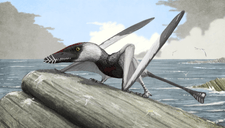 Dorygnathus on terrestrial pose 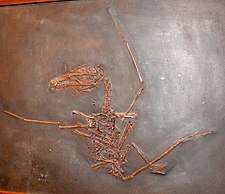 Nearly complete Dorygnathus | ||
Dinosauria
| Genus | Species | Location | Material | Notes | Images |
|---|---|---|---|---|---|
|
|
Cervical Vertebrae, dorsal vertebrae, limbs and possible ulna |
An indeterminate possible Theropod dinosaur, possibly Neotheropoda. Hasn't been revised since 1984. |
||
|
Sauropodiformes[300] |
|
|
3 cm long, tooth-studded fragment of a lower jaw |
An indeterminate possible Sauropodomorph dinosaur, possibly a member of Sauropodiformes (Resemble Yunnanosaurus teeth).[300] The Fossil was reported from the Lias Epsilon level, that on Oedhof is occupied by the Posidonia Shale.[300] It was found with abundant Plant debris and Belemnite remains.[300] Hasn't been revised since 1956 |
|
|
|
Tibia and astragalus |
A Gravisaurian Sauropod. One of the few formally described from the Toarcian. Has been related with Vulcanodon, although more recent studies placed it as a relative of Rhoetosaurus.[302] It has been claimed to be a small sauropod with a size of 4 m, altrought the tibia measures 405 to 410 mm, leading to a 6.7 m long sauropod. Molina Pérez & Larramendi, stimated a modern size of 6.2 to 6.7 m long, with a weight of 1.3 tonnes.[303] |
| |
Synapsida
| Genus | Species | Location | Material | Notes | Images |
|---|---|---|---|---|---|
|
|
3 Teeth |
The specimens were listed on several notes on the 1800s (As "mammal teeth"), although its existence has not been proved. Can be related to the Trithelodontidae or other late surviving Cynodonts by related characters, such as Irajatherium, but also to the Mammaliformes. If its presence is proved, it would be the first Synapsid found on the Posidonia Shale. |
||
References
- Hess, H. (1999). Lower Jurassic Posidonia Shale of Southern Germany. Fossil crinoids, 183-196.
- Martill, D. M. (1993). Soupy substrates: a medium for the exceptional preservation of ichthyosaurs of the Posidonia Shale (Lower Jurassic) of Germany. Kaupia, 2, 77-97.
- Schmid–Röhl, A., & Röhl, H. J. (2003). Overgrowth on ammonite conchs: environmental implications for the Lower Toarcian Posidonia Shale. Palaeontology, 46(2), 339-352.
- Böhm, F., & Brachert, T. C. (1993). Deep-water stromatolites and Frutexites Maslov from the early and Middle Jurassic of S-Germany and Austria. Facies, 28(1), 145–168. doi:10.1007/bf02539734
- Prauss, M., Ligouis, B., & Luterbacher, H. (1991). Organic matter and palynomorphs in the ‘Posidonienschiefer’(Toarcian, Lower Jurassic) of southern Germany. Geological Society, London, Special Publications, 58(1), 335-351.
- Prauss, M. (1996). The Lower Toarcian Posidonia Shale of Grimmen, Northeast Germany. Implications from the palynological analysis of a near-shore section. Neues Jahrbuch für Geologie und Paläontologie-Abhandlungen, 107-132.
- Wille,W. et al. (1979) Dinoflagellates from the Lias of Sw Germany. [ Dinoflagellaten aus dem Lias Sмdwestdeutschlands. ] Neues Jahrbuch fмr Geologie und Paleontologie. Abhandlungen Vol. 158 # 2 P. 221- 258
- Wille,W. (1982) Evolution and ecology of Upper Liassic dinoflagellates from southwest Germany. Neues Jahrbuch fмr Geologie und Paleontologie. Abhandlungen Vol. 164 # 1 P. 74- 82
- Lund,J.J. (1996) Jurassic and Cretaceous microfloras used to determine the stratigraphical succession of steeply dipping strata along the Prahl Fault, Dobenwohr Hafgraben, northeast Bavaria. Neues Jahrbuch fмr Geologie und Pal¤ontologie. Abhandlungen Vol. 200 # 1 P. 133- 147
- Gotch, H. (1964). Planktonische Kleinformen aus dem Lias-Dogger Grenzbereich Nord- und Süddeutschlands. Neues Jahrb. Geol. Paläontol. Abh. 119: 113-133.
- Gorbanenko, O. O., & Ligouis, B. (2014). Changes in optical properties of liptinite macerals from early mature to post mature stage in Posidonia Shale (Lower Toarcian, NW Germany). International journal of coal geology, 133, 47-59.
- Schouten, S., van Kaam-Peters, H. M., Rijpstra, W. I. C., Schoell, M., & Damste, J. S. S. (2000). Effects of an oceanic anoxic event on the stable carbon isotopic composition of early Toarcian carbon. American Journal of Science, 300(1), 1–22.
- Madler,K.A. (1963) Organic microstructures of the Posidonia Shale. [ III. Die figurierten organischen Bestandteile der Posidonoenschiefer. ] Beihefte zum Geologischen Jahrbuch Vol. 58 P. 287- 406
- Visentin S, Erba E, Mutterlose J. 2019. Biostratigraphic constraints of the Early Toarcian Oceanic Anoxic Event: new data from calcareous nannofossil investigations of Boreal and Tethyan sections. PeerJ Preprints 7:e27999v1 https://doi.org/10.7287/peerj.preprints.27999v1
- Madler,K.A. (1969) Tasmanites and related planktonic organisms from the Posidonian Shales. [ Tasmanites und verwandte planktonformen aus dem Posidonienschiefer-Meer. ] International Conference on Planktonic Microfossils, 1st, Geneva, 1967, Proceedings. E. J. Brill, Leiden. P. 375- 377
- Wetzel,O. (1958) New microfossils from the Lias, especially from the Posidonian Shale. [ Neue mikrofossilien aus dem Lias, insbesondere aus dem Posidonienschiefer. ] Palaeontologische Zeitschrift Vol. 32 # 1 P. 15- 15
- Ruebsam, W., & Schwark, L. (2017). Phytoplankton community dynamics during the Early Toarcian Oceanic Anoxic Event deduced from high-resolution biomarker investigation. In Proceedings of the 1st International Workshop on the Toarcian Oceanic Anoxic Event (IW-TOAE): Impact on Marine Carbon Cycle and Ecosystems, IGCP-655, Jaén (pp. 101–102).
- AMMON VON L. 1875. Die Jura Ablagerungen zwischen Regensburg und Passau. Theodor Ackermann, München
- BRACH ERT Th. 1987. MakrofossilfUhrung der "Siemensi-Geoden" (Mittlerer Lias Epsilon, Unteres Toarcium) von KerkhofeniOberpfalz ( Bayern) : Neue Insekten- und Pflanzenfunde. Geologische Blätter NO-Bayern, 37(3-4) : 217–240.
- Schulz,E. et al. (1966) Table of distribution of spores and pollen in the German Lias and Dogger. comments on the table of stratigraphic distribution of spores and pollen in the Liassic and Dogger [ Tabelle der verteilung der sporen und pollen im Deutschen Lias und Dogger ] Abhandlungen des Zentralen Geologischen Instituts # 8 P. 1- 200
- Madler,K.A. (1956) Pollen analytical studies on the Posidonian Shale. [ Pollenanalytische untersuchungen im Posidonienschiefer ] Pal¤eontologische Zeitschrift Vol. 30 # 1 P. 18- 18
- Wilde, V. (2001). Die Landpflanzen-Taphozönose aus dem Posidonienschiefer des Unteren Jura (Schwarzer Jura [Epsilon], Unter-Toarcium) in Deutschland und ihre Deutung. Staatliches Museum für Naturkunde.
- Thomas, E. (1981). Das Unterkarbon von Aprath im Bergischen Land. Aufschluss, Jg.32, Nr.7/8, S.276-306
- SALFELD, H. (1907): Fossile Land-Pflanzen der Rät- und Juraformation Südwestdeutschlands. – Palaeontographica, 54/4: 163–204, Taf. 14–22; Stuttgart. – (1909): Beiträge zur Kenntnis jurassischer Pflanzenreste aus Norddeutschland. – Palaeontographica, 56/1: 1–35, 2 Abb., Taf. 1–6. Stuttgart.
- BRACHERT, T. C. (1987): Makrofossilführung der „Siemensi-Geoden“ (Mittlerer Lias Epsilon, Unteres Toarcium) von Kerkhofen/Oberpfalz (Bayern): Neue Insekten- und Pflanzenfunde. – Geologische Blätter für Nordost-Bayern und angrenzende Gebiete, 37(3/4): 217–240, 3 Abb., 2 Tab., Taf. 17–20; Erlangen.
- MAUBEUGE, P. (1947). Sur l'existence du genre Neocalamites dans le Toarcien du Grand-Duché de Luxembourg. Archives de l'Institut Gratul-Ducal de Luxembourg, Section des Sciences naturelles, physiques et mathématiques, nouvelle série, 17, 59-64.
- Manfred Jäger (2005).Das Fossilienmuseum im Werkforum. Führer durch die Ausstellung von Jura-Fosslilien. 3.Aufl. Dotternhausen.
- Vogellehner, D. (1982). Zur Anatomie und Systematik von «Treibhölzern» aus dem Posidonienschiefer von Holzmaden (Schwäb. Alb).
- Thiergart,F. (1944) The plant remains of the Posidonia Shale. [ Die Pflanzenreste des Posidonienschiefers. ] Archiv fur Lagerstattenforschung, zur Palaogeographie und Bitumen-Fuhrung des Posidonihiefers Im Deutschen Lias Vol. 77 P. 45- 48
- Böttcher, R. (1998): Leben und Tod im Meer des Posidonienschiefers. - In: E. P. J. Heizmann (Hrsg.): Erdgeschichte Mitteleuropäischer Regionen (2). Vom Schwarzwald zum Ries, S. 83-96, 25 Abb.; München (Pfeil).
- KURR, J. G. (1845): Beiträge zur fossilen Flora der Juraformation Württembergs. – Anhang an: Einladungs-Schrift zu der Feier des Geburtsfestes Sr. Majestät des Königs Wilhelm von Württemberg in der königl. polytechnischen Schule zu Stuttgart den 27. September 1845: 1–17, 3 Taf.; Stuttgart (Guttenberg).
- Küpper, K. (1968). Die Gattung Otozamites. Taxon, 17(5), 548–552.
- Samylina, V. A., & Kiritchkova, A. I. (1991). The genus Czekanowskia.
- SALFELD, Palaeontographica, 54(4): 186–188, Taf. 18
- Saporta. – BARALE, Documents des Laboratoires de Géologie Lyon, 81: 172–177, Abb. 45, Taf. 49–50.
- URLICHS, WILD & ZIEGLER, Stuttgarter Beitr. Naturkde.,Reihe C, 11: Abb. 50.
- MÜLLER-STOLL, W. R. & SCHULTZE-MOTEL, J.(1990): Gymnospermen-Hölzer des Deutschen Jura. Teil 3: Abietoid (modern) getüpfelte Hölzer. – Zeitschrift der deutschen geologischen Gesellschaft, 141/1–2: 61–77, 2 Abb., 2 Taf.; Hannover
- Philippe, M. (1991). Bois fossiles du jurassique de Franche-Comté (Doctoral dissertation, Lyon 1).
- Süss, H., & Philippe, M. (1993). Holzanatomische Untersuchungen an einem fossilen Holz, Circoporoxylon grandiporosum Müller‐Stoll et Schultze‐Motel, aus dem Unteren Jura von Frankreich Mit 4 Abbildungen, einer Tabelle und 2 Tafeln. Feddes Repertorium, 104(7‐8), 451–463.
- Matzke, A. T., & Maisch, M. W. (2019). Palaeoecology and taphonomy of a Seirocrinus (Echinodermata: Crinoidea) colony from the Early Jurassic Posidonienschiefer Formation (Early Toarcian) of Dotternhausen (SW Germany). Neues Jahrbuch für Geologie und Paläontologie-Abhandlungen, 291(1), 89–107.
- Philippe, M., Barbacka, M., Gradinaru, E., Iamandei, E., Iamandei, S., Kázmér, M., ... & Zatoń, M. (2006). Fossil wood and Mid-Eastern Europe terrestrial palaeobiogeography during the Jurassic–Early Cretaceous interval. Review of Palaeobotany and Palynology, 142(1-2), 15–32.
- SCHULTZE-MOTEL, J. (1960): Anatomische Untersuchungen an mesozoischen Gymnospermen-Hölzern. – Dissertation Pädagogische Hochschule Potsdam. 156 S., 25 Taf.; Potsdam. – [Unveröffentlicht; Zitat nach VOGELLEHNER (1982), die betreffende Arbeit konnte bisher nicht eingesehen werden] – (1962): Anatomische Untersuchungen an mesozoischen Gymnospermen-Hölzern. – wilde, landpflanzen-taphocoenose aus dem posidonienschiefer 11 Wissenschaftliche Zeitschrift der Pädagogischen Hochschule Potsdam. Mathematischnaturwissenschaftliche Reihe, 7(1961/62): 343–344; Potsdam. – [Autorreferat der unveröffentlichten Dissertation]
- Philippe, M., Zijlstra, G., Barbacka, M., & Greguss. (1999). Greguss's morphogenera of homoxylous fossil woods: a taxonomic and nomenclatural review. Taxon, 667-676.
- Philippe, M. (1991). Bois fossiles du jurassique de Franche-Comté (Doctoral dissertation, Lyon 1).
- Polgári, M., Philippe, M., Szábo-Drubina, M., & Tóth, M. (2005). Manganese-impregnated wood from a Toarcian manganese ore deposit, Epleny mine, Bakony Mts., Transdanubia, Hungary. Neues Jahrbuch für Geologie und Paläontologie-Monatshefte, 175–192.
- Philippe, M., Pacyna, G., Wawrzyniak, Z., Barbacka, M., Boka, K., Filipiak, P., ... & Uhl, D. (2015). News from an old wood—Agathoxylon keuperianum (Unger) nov. comb. in the Keuper of Poland and France. Review of Palaeobotany and Palynology, 221, 83–91.
- Mueller-Stoll, W. R. (1986). Evolutionary trends in gymnospermous wood structures during Mesozoic-Protopinaceous woods in the German Jurassic.
- Bamford, M. K., Philippe, M., & Thévenard, F. (2016). Long overdue extinction of the Protopinaceae. Review of palaeobotany and palynology, 234, 25–30.
- Philippe, M., & Thevenard, F. (1996). Distribution and palaeoecology of the Mesozoic wood genus Xenoxylon: palaeoclimatological implications for the Jurassic of Western Europe. Review of Palaeobotany and Palynology, 91(1-4), 353–370.
- Mtiller-Stoll, W.R. and Schultze-Motel, J., 1988. Gymnospermen Hölzer des deutschen Jura. I: Xenoxylon und Dadoxylon. Z. Dtsch. Geol. Ges., 139:63 81.
- Hallam, A. (1998). The determination of Jurassic environments using palaeoecological methods. Bulletin de la Société géologique de France, 169(5), 681–687.
- Savrda, C. E., & Bottjer, D. J. (1989). Anatomy and Implications of Bioturbated Beds in “Black Shale” Sequences: Examples from the Jurassic Posidonienschiefer (Southern Germany). PALAIOS, 4(4), 330. doi:10.2307/3514557
- Simpson, S. (1956). On the trace-fossil Chondrites. Quarterly Journal of the Geological Society, 112(1-4), 475–499.
- Osgood, R. G. (1975). The history of invertebrate ichnology. In The study of trace fossils (pp. 3–12). Springer, Berlin, Heidelberg.
- Hertweck, G., Wehrmann, A., & Liebezeit, G. (2007). Bioturbation structures of polychaetes in modern shallow marine environments and their analogues to Chondrites group traces. Palaeogeography, Palaeoclimatology, Palaeoecology, 245(3-4), 382–389.
- Izumi, K. (2012). Formation process of the trace fossil Phymatoderma granulata in the Lower Jurassic black shale (Posidonia Shale, southern Germany) and its paleoecological implications. Palaeogeography, Palaeoclimatology, Palaeoecology, 353, 116-122.
- Izumi, K. (2013). Geochemical composition of faecal pellets as an indicator of deposit‐feeding strategies in the trace fossil P hymatoderma. Lethaia, 46(4), 496-507.
- Bromley, R. G., & Ekdale, A. A. (1986). Composite ichnofabrics and tiering of burrows. Geological magazine, 123(1), 59-65.
- Brongniart, A. 1823. Observations sur les fucoides. Soc. Hist. Natur. Paris, Mem., 1:301-320.
- KOTAKE, N. (1992). Deep‐sea echiurans: possible producers of Zoophycos. Lethaia, 25(3), 311-316.
- Zhang, Li-Jun; Zhao, Zhao (2015). "Complex behavioural patterns and ethological analysis of the trace fossil Zoophycos: Evidence from the Lower Devonian of South China". Lethaia. 49 (2): 275–284. doi:10.1111/let.12146.
- Brongniart, A. 1823. Observations sur les fucoides. Soc. Hist. Natur. Paris, Mem., 1:301-320.
- Van Acken, D., Tütken, T., Daly, J. S., Schmid-Röhl, A., & Orr, P. J. (2019). Rhenium‑osmium geochronology of the Toarcian Posidonia Shale, SW Germany. Palaeogeography, Palaeoclimatology, Palaeoecology, 534, 109294.
- Keighley, D. G., & Pickerill, R. K. (1995). Commentary: the ichnotaxa Palaeophycus and Planolites: historical perspectives and recommendations.
- Oschmann, W. (2000). Der Posidonienschiefer in Südwest-Deutschland, Toarcium, Unterer Jura. In Europäische Fossillagerstätten (pp. 137-142). Springer, Berlin, Heidelberg.
- Bandel, K. (1973). A new name for the ichnogenus Cylindrichnus Bandel, 1967. Journal of Paleontology, 1002-1002.
- Nützel, A. & Schulbert, C. (2017): Faunenumschwung im frühen Jura Frankens. – Geologische Blätter für Nordost-Bayern, 67: 217-230, 7 Abb.; Erlangen
- W. Ohmert, V. Allia C. Arias et al. 1996. Die Grenzziehung Unter-/Mitteljura (Toarcium/Aalenium) bei Wittnau und Fuentelsaz [Determinig the boundary between Toarcium/Aalenium near Wittnau and Fuentelsaz]. Informationen Geologisches Landesamt Baden-Württemberg 8:1–52
- F. Papier. 2001. Die Gundershoffener Klamm. Fossilien 6/01:368–374
- A. Goldfuss, Petrefacta Germaniae. I. Divisio secunda: Radiariorum Reliquiae—Strahlenthiere der Vorwelt (Arnz & Co, Dusseldorf, 1831), pp. 165–240
- Ippolitov, A. P., Vinn, O., Kupriyanova, E. K., Jäger, M. (2014): Written in stone: history of serpulid polychaetes through time. – Memoirs of Museum Victoria, 71: 123–159
- K.O.A. Parsch. 1956. Die Serpulidenfauna des südwestdeutschen Jura. Palaeontographica Abteilung A 107:211–240
- Etter, W. (1994). Taphonomie. In Palökologie (pp. 128-176). Birkhäuser, Basel.
- KUHN, O. (1947): Gliederung und Fossilführung des Lias und Doggers in Franken. – Ber. naturforsch. Ges. Bamberg, 30: S. 33–89; Bamberg
- Jäger, M., & Schubert, S. (2008). Das Ober-Pliensbachium (Domerium) der Herforder Liasmulde; Teil 2, Serpuliden (Kalkröhrenwürmer). Geologie und Paläontologie in Westfalen, 71, 47-75.
- Vinn, O.; Mutvei, H. (2009). "Calcareous tubeworms of the Phanerozoic" (PDF). Estonian Journal of Earth Sciences. 58 (4): 286–296. doi:10.3176/earth.2009.4.07. Retrieved 2012-09-16.
- Manum,S.B. et al. (1991) Clitellate cocoons in freshwater deposits since the Triassic Zoologica Scripta Vol. 20 # 4 P. 347- 366
- Münster, R. G. (1831). Petrefacta Germaniae. In, Arnz & Co, 252.
- MÜNSTER, G. (1831). GRAF ZU (1831): Über das geognostische Vorkommen der Ammoneen in Deutschland. Jahrbuch für Mineralogie, Geognosie, Geologie und Petrefaktenkunde, 367-375.
- Agassiz, L. (1840). Études critiques sur les mollusques fossiles. L'auteur.
- Caswell, B. A., Coe, A. L., & Cohen, A. S. (2009). New range data for marine invertebrate species across the early Toarcian (Early Jurassic) mass extinction. Journal of the Geological Society, 166(5), 859–872.
- Roemer, F. A. (1836). Die Versteinerungen des Nord-deutschen Oolithen-Gebirges, von Friedrich Adolph Roemer,... Hahn.
- Kuhn, O., & Etter, W. (1994). Der Posidonienschiefer der Nordschweiz: Lithostratigraphie, Biostratigraphie und Fazies. Eclogae geologicae Helvetiae, 87(1), 113-138.
- Jefferies, R. P. S., & Minton, P. (1965). The mode of life of two Jurassic species of Posidonia (Bivalvia). Palaeontology, 8(1), 156-185.
- Hauff, B. (1921). Untersuchung der Fossilfundstätten von Holzmaden im Posidonienschiefer des Oberen Lias Württembergs. Palaeontographica (1846-1933), 1-42.
- Kauffman, E.G., 1978. Benthic environments and paleoecology of the Posidonienschiefer (Toarcian). Neues Jahrb. Geol. Paleiontol. Abh., 157:18 36.
- Kauffman, E.G., 1981. Ecological reappraisal of the German Posidonienschiefer (Toarcian) and the stagnant basin model. In: J. Gray et al. (Editors), Communities of the Past. Hutchinson Ross, Stroudsburg, PA, pp. 311-381.
- Seilacher, A. (1982). Posidonia Shales (Toarcian, S. Germany): stagnant basin model revalidated. STEM Mucchi.
- Oschmann, W. (1994). Adaptive pathways of benthic organisms in marine oxygen-controlled environments. Neues Jahrbuch für Geologie und Paläontologie. Abhandlungen, 191(3), 393-444.
- Savrda, C. E., & Bottjer, D. J. (1991). Oxygen-related biofacies in marine strata: an overview and update. Geological Society, London, Special Publications, 58(1), 201-219.
- Röhl, H. J. (1998). Hochauflösende palökologische und sedimentologische Untersuchungen im Posidonienschiefer (Lias e)[epsilon)] von SW-Deutschland. Inst. und Museum für Geologie und Paläontologie.
- Teichert, S., & Nützel, A. (2015). Early Jurassic anoxia triggered the evolution of the oldest holoplanktonic gastropod Coelodiscus minutus by means of heterochrony. Acta Palaeontologica Polonica, 60(2), 269–276.
- BROSAMLEN, R. 1909. Beitrag zur Kenntnis der Gastropoden des schwäibischen Jura. - Palaeontographica 56: 177-321.
- Gründel, J., Nützel, A., & Schulbert, C. (2009). Toarctocera (Gastropoda, Aporrhaidae): a new genus from the Jurassic (Toarcian/Aalenian) of South Germany and the early evolutionary history of the family Aporrhaidae. Paläontologische Zeitschrift, 83(4), 533.
- Bandel, K., & Hemleben, C. (1987). Jurassic heteropods and their modern counterparts (planktonic Gastropoda, Mollusca). Neues Jahrbuch für Geologie und Paläontologie, Abhandlungen, 174, 1-22.
- L. Rulleau. 2008. Les Nautiles du Lias et du Dogger de la Région Lyonnaise 1-149
- Schulbert, C. (2001). Die Ammonitenfauna und Stratigraphie der Tongrube Mistelgau bei Bayreuth (Oberfranken) (Vol. 4). Digital Druck AG.
- POMPECKJ, J. (1901). Der Jura zwischen Regensburg und Regenstauf: Geognostische Jahreshefte, v. 14.
- W. Riegraf. 1985. Biostratigraphie, Fauna und Mikropaläontologie des Untertoarcium-Profiles von Unterstürmig (Oberfranken, Süddeutschland). Geologische Blätter für Nordost-Bayern 34/35:241–272
- C. Schulbert. 2001. Die Ammonitenfauna und Stratigraphie der Tongrube Mistelgau bei Bayreuth (Oberfranken). Beihefte zu den Berichten der Naturwissenschaftlichen Gesellschaft Bayreuth e.V 4:1–183
- Jäger, M., & Fraaye, R. (1997). The diet of the Early Toarcian ammonite Harpoceras falciferum. Palaeontology, 40(2), 557-574.
- H. Keupp and R. Kohring. 1993. Ein Magensteinfund aus dem Lias Epsilon von Altdorf (Mittelfranken); (A gastrolith from the Lias Epsilon of Altdorf (Middle Franken). Geologische Blätter für Nordost-Bayern und angrenzende Gebiete 43(1-3):95–104
- Hille, P. J. (2002). De fossielen uit de Posidonienschiefer van Holzmaden en omgeving. GEA, 35(2), 8–17.
- D. Delsate and R. Weis. 2010. La Couche à Crassum (Toarcien moyen) au Luxembourg: stratigraphie et faunes de la coupe de Dudelange-Zoufftgen. Ferrantia 62:35-62
- Arp, G., & Gropengießer, S. (2016). The Monotis–Dactylioceras Bed in the Posidonienschiefer Formation (Toarcian, southern Germany): condensed section, tempestite, or tsunami-generated deposit?. PalZ, 90(2), 271–286.
- Phylloceras heterophyllum (Sowerby, 1820) in Species 2000 & ITIS Catalogue of Life: 2019, Catalogue of Life
- Fuchs, D., Keupp, H., & Schweigert, G. (2013). First record of a complete arm crown of the Early Jurassic coleoid Loligosepia (Cephalopoda). Paläontologische Zeitschrift, 87(3), 431–435.
- Doguzhaeva, L. A., & Mutvei, H. (2003). Gladius composition and ultrastructure in extinct squid-like coleoids: Loligosepia, Trachyteuthis and Teudopsis. Revue de Paléobiologie, 22(2), 877-894.
- Fuchs, D., & Weis, R. (2008). Taxonomy, morphology and phylogeny of Lower Jurassic loligosepiid coleoids (Cephalopoda). Neues Jahrbuch Für Geologie Und Paläontologie - Abhandlungen, 249(1), 93–112. doi:10.1127/0077-7749/2008/0249-0093
- Riegraf, W. (1997). On the proposed conservation of the names Geopeltis Regteren Altena, 1949, Geoteuthis Muenster, 1843, Jeletzkyteuthis Doyle, 1990, Loligosepia Quenstedt, 1839, Parabelopeltis Naef, 1921, Paraplesioteuthis Naef, 1921 and Belemnotheutis montefiorei Buckman, 1880 (Mollusca, Coleoidea). BULLETIN OF ZOOLOGICAL NOMENCLATURE, 54, 184-184.
- VOLTZ, P. L. (1840): Observations sur les Belopeltis ou lames dorsales de Bélemnites. – Mémoires du Société d’Histoire Naturelle de Strasbourg, 1: 1-38
- MÜNSTER, G. GRAF ZU (1843): Die schalenlosen Cephalopoden im unteren Jura, den Lias-Schiefern von Franken und Schwaben. – Beiträge zur Petrefaktenkunde, 6: 57–77
- Fischer, K. C., & KC, F. (1981). Chitinobelus acifer ngn sp., ein ungewöhnlicher Belemnit aus dem Lias epsilon von Holzmaden.
- Bode, A. (1933). Chondroteuthis wunnenbergi ngn sp., eine neue Belemnoideenform, in gunstiger Erhaltung. Sonderabdruck aus dem 25. Jahresbericht des Niedersachsischen geologischen Vereins zu Hannover (Geologische Abteilung der Naturhistorischen Gesellschaft zu Hannover), 25, 33–66.
- Schlegelmilch, R. (1998). Formenkundlicher Teil. In Die Belemniten des süddeutschen Jura (pp. 39-89). Spektrum Akademischer Verlag, Heidelberg.
- Riegraf, W. (1980). Revision der Belemniten des Schwäbischen Jura.
- Riegraf, W. (2000). The belemnites described by Baron Ernst Friedrich von Schlotheim (1764–1832). PalZ, 74(3), 281–303.
- Riegraf, W., & Reitner, J. (1979). Die" Weichteilbelemniten" des Posidonienschiefers (Untertoarcium) von Holzmaden (Baden-Württemberg) sind Fälschungen. Neues Jahrbuch für Geologie und Paläontologie,, (5), 291–304.
- Fuchs, D., Donovan, D. T., & Keupp, H. (2013). Taxonomic revision of “Onychoteuthis” conocauda Quenstedt, 1849 (Cephalopoda: Coleoidea). Neues Jahrbuch für Geologie und Paläontologie-Abhandlungen, 270(3), 245–255.
- Jenny, D., Fuchs, D., Arkhipkin, A.I. et al. Predatory behaviour and taphonomy of a Jurassic belemnoid coleoid (Diplobelida, Cephalopoda). Sci Rep 9, 7944 (2019). https://doi.org/10.1038/s41598-019-44260-w
- W. Riegraf. 1987. On Lower and Upper Jurassic dibranchiate cephalopods from Germany and England. Palaeontologische Zeitschrift 61:261–272
- Fuchs, D., & Weis, R. (2010). Taxonomy, morphology and phylogeny of Lower Jurassic teudopseid coleoids (Cephalopoda). Neues Jahrbuch für Geologie und Paläontologie-Abhandlungen, 257(3), 351–366.
- Volk, K. G. (1923). Im Jura. In Geologisches Wanderbuch (pp. 75–149). Vieweg+ Teubner Verlag, Wiesbaden.
- Beyermann, K., & Hasenmaier, D. (1977). Identification of 180 million years old, probably unchanged melanine.
- Glass, K., Ito, S., Wilby, P. R., Sota, T., Nakamura, A., Bowers, C. R., ... & Wakamatsu, K. (2013). Impact of diagenesis and maturation on the survival of eumelanin in the fossil record. Organic geochemistry, 64, 29–37.
- Schweigert, G. (2007). Juracyclus posidoniae n. gen. and sp., the first cycloid arthropod from the Jurassic. Journal of Paleontology, 81(1), 213–215.
- G. Schweigert, R. Fraaije, P. Havlik and A. Nützel. 2013. New Early Jurassic hermit crabs from Germany and France. Journal of Crustacean Biology 33:802–817
- Fraaye, R., & Jäger, M. (1995). Decapods in ammonite shells: examples of inquilinism from the Jurassic of England and Germany. Palaeontology, 38(1), 63-76.
- Quenstedt, F. A. 1850[1854]. Ueber Mecochirus im braunen Jura bei Gammelshausen und einige andere Krebse. Jahresh. Ver. vaterl. Naturlt. Wurttembetg, 6: 186–197
- Schweigert, G. (2003). The lobster genus Uncina Quenstedt, 1851 (Crustacea: Decapoda: Astacidea: Uncinidae) form the Lower Jurassic. Stuttgarter Beitrage zur Naturkunde, 332, 1-43.
- Audo, D. (2016). Tonneleryon, a new gregarious polychelidan lobster from the early Toarcian Posidonia Shale of Holzmaden (Germany). Neues Jahrbuch Für Geologie Und Paläontologie - Abhandlungen, 280(3), 285–298. doi:10.1127/njgpa/2016/0580
- Beurlen, K. (1944). Neue Reste von Proeryon (Crustacea Decapoda, Eryonidea). Neues Jahrb Miner Geolog Paläont, 88, 374–384.
- Beurlen, K. (1930). Nachträge zur Decapodenfauna des schwäbischen Jura. Universität.
- O. Kuhn Neue Crustacea Decapoda und Insecta aus dem untersten Lias ɛ von Nordfranken. Palaeontographica Abteilung A, 101 (1952), pp. 153–166
- H. Meyer von Beiträge zu Eryon, einem Geschlechte fossiler langschwänziger Krebse, Nova Acta Academiae Caesareae Leopoldino-Carolinae Germanicae Naturae Curiosorum, 18 (1) (1836), pp. 272-284
- K. Beurlen Die Decapoden des Schwäbischen Jura mit Ausnahme der aus den oberjurassischen Plattenkalken stammenden. Beiträge zur Systematik und Stammesgeschichte der Decapoden Palaeontographica, 70 (1928), pp. 115–278
- Audo, D., Schweigert, G., & Charbonnier, S. (2019, November). Proeryon, a geographically and stratigraphically widespread genus of polychelidan lobsters. In Annales de Paléontologie (p. 102376). Elsevier Masson.
- Hauff B, Hauff RB. 1981. Das Holzmadenbuch. 3rd ed. Holzmaden: selfpublished
- Gregor, H. J. (2008). Der Jura in Deutschland. Tropische Meere–Land unter. Biologie in unserer Zeit, 38(2), 102–109.
- Schweigert, G., & Röper, M. (2001). Neue Krebse der Gattung Palaeastacus (Crustacea: Decapoda: Erymidae) aus oberjurassischen Plattenkalken Süddeutschlands. Staatliches Museum für Naturkunde.
- Seilacher, A., Reif, W. E., & Westphal, F. (1985). Sedimentological, ecological and temporal patterns of fossil Lagerstätten. Philosophical Transactions of the Royal Society of London. B, Biological Sciences, 311(1148), 5–24.
- Beurlen K (1930) Nachtra¨ge zur Decapodenfauna des schwa¨bischen Jura. I. Neue Decapodenfunde aus dem Posidonienschiefer von Holzmaden. Neues Jahrb Miner Geolog Pala¨ont 64: 219–234.
- Van Straelen V. 1925. Contribution à l’étude des crustacés décapodes de la période jurassique. Mémoires de la Classe des Sciences de l’Académie royale de Belgique 7: 1–462.
- Schweitzer CE, Feldmann RM, Garassino A, Karasawa H, Schweigert G. 2010. Systematic list of fossil decapod crustacean species. Crustaceana Monographs 10: 1–222.
- Schweigert, G. (2013). A new record of the enigmatic lobster genus Stenodactylina Beurlen, 1928 (Crustacea: Decapoda: Erymidae) from the Middle Jurassic of south-western Germany. Paläontologische Zeitschrift, 87(3), 409–413.
- Devillez, J., & Charbonnier, S. (2019). Review of the Early and Middle Jurassic erymid lobsters (Crustacea: Decapoda) Révision des Érymides (Crustacea: Decapoda) du Jurassique inférieur et moyen. Bulletin de la Société Géologique de France, 190(1).
- Beurlen K. 1928. Die Decapoden des Schwäbischen Jura mit Ausnahme der aus den oberjurassischen Plattenkalken stammenden. Palaeontographica 70: 115–278.
- Förster R, Rieber H. 1982. Der älteste Vertreter der Gattung Palaeastacus (Crustacea, Decapoda), Palaeastacus argoviensis n. sp., aus dem unteren Dogger der Nordschweiz. Eclogae geologicae Helvetiae 75(3): 773–778.
- Haug, J. T., Haug, C., & Schweigert, G. (2019). The oldest “intermetamorphic” larva of an achelatan lobster from the Lower Jurassic Posidonia Shale, South Germany. Acta Palaeontologica Polonica, 64(4), 685–692.
- Klompmaker AA, Fraaije RHB. 2012. Animal Behavior frozen in time: gregarious behavior of early jurassic lobsters within an ammonoid body chamber. PLoS One. 7(3):e31893. doi:10.1371/journal
- Gale, A., & Schweigert, G. (2016). A new phosphatic‐shelled cirripede (Crustacea, Thoracica) from the Lower Jurassic (Toarcian) of Germany–the oldest epiplanktonic barnacle. Palaeontology, 59(1), 59–70.
- Bode, A. (1951). Ein liassischer Scorpionide. Palaeontologische Zeitschrift, 24(1–2), 58–65.
- Dunlop, J. A., Kamenz, C., & Scholtz, G. (2007). Reinterpreting the morphology of the Jurassic scorpion Liassoscorpionides. Arthropod structure & development, 36(2), 245–252.
- Ansorge, J. (2003). Insects from the lower Toarcian of middle Europe and England. Acta zoologica cracoviensia, 46(SUPPL.), 291–310.
- J. Ansorge. 1999. Heterophlebia buckmani (Brodie 1845) (Odonata: "Anisozygoptera") - das erste Insekt aus dem untertoarcischen Posidonienschiefer von Holzmaden (Württemberg, SW Deutschland). Stuttgarter Beiträge zur Naturkunde Serie B (Geologie und Paläontologie) 275:1-9
- A. Bode. 1953. Die Insektenfauna des Ostniedersachsischen Oberen Lias. Palaeontographica Abteilung A 103:1–375
- J. Ansorge. 2002. Revision of the "Trichoptera" described by Geinitz and Handlirsch from the Lower Toarcian of Dobbertin (Germany) based on new material. Proceedings of the 10th International Symposium on Trichoptera - Nova Supplementa Entomologica 15:55–74
- W. Etter and O. Kuhn. 2000. An articulated dragonfly (Insecta, Odonata) from the Upper Liassic Posidonia Shale of Northern Switzerland. Palaeontology 43:967–977
- A. Nel, X. Martínez-Delclòs, J. C. Paicheler and M. Henrotay. 1993. Les "Anisozygoptera" fossiles Phylogenie et classification (Odonata). Martinia 3:1-311
- G. Bechly. 2018. First record and a new species of the fossil dragonfly genus Proinogomphus (Odonata: Liassogomphidae) from the Early Jurassic of Bascharage in the Grand Duchy of Luxembourg. Zootaxa 4450:108-114
- Handlirsch, A. (1939). Neue Untersuchungen über die fossilen Insekten mit Ergänzungen und Nachträgen sowie Ausblicken auf phylogenetische, palaeogeographische und allgemein biologische Probleme. II. Teil. Annalen des naturhistorischen Museums in Wien, 1–240.
- Nel, A. N. D. R. É., Bechly, G. Ü. N. T. E. R., Delclòs, X. A. V. I. E. R., & Huang, D. Y. (2009). New and poorly known Mesozoic damsel-dragonflies (Odonata: Isophlebioidea: Campterophlebiidae, Isophlebiidae). Palaeodiversity, 2, 209–232.
- A. Nel and R. Weis. 2017. A new Early Jurassic damselfly from the Grand Duchy of Luxembourg (Odonata: Campterophlebiidae). Alcheringa 41:378-382
- G. Fleck, G. Bechly, X. Martinez-Delclos, E. Jarzembowski, R. Coram and A. Nel. 2003. Phylogeny and classification of the Stenophlebioptera (Odonata: Epiproctophora). Annales de la Société Entomologique de France 39(1):55-93
- P. Vršanský and J. Ansorge. 2007. Lower Jurassic cockroaches (Insecta: Blattaria ) from Germany and England. African Invertebrates 48(1):103–126
- O. Kuhn. 1952. Neue Crustacea Decapoda und Insecta aus dem Untersten Lias von Nordfranken. Palaeontographica Abteilung A 101:153-166
- Berger, G. (1989). Über Insektenfunde beim Kanalbau. Fossilien, 1989(1), 44-47.
- Ansorge, J. (1996). Zur systematischen Position vonSchesslitziella haupti Kuhn 1952 (Insecta: Phasmatodea) aus dem Oberen Lias von Nordfranken (Deutschland). Paläontologische Zeitschrift, 70(3-4), 475–479.
- Kopeć, K., Soszyńska-Maj, A., Gehler, A., Ansorge, J., & Krzemiński, W. (2018). Mecoptera and Diptera from the early Toarcian (Early Jurassic) deposits of Wolfsburg–Große Kley (Lower Saxony, Germany). Earth and Environmental Science Transactions of the Royal Society of Edinburgh, 107(2-3), 163-171.
- Ansorge, J. (1994). Tanyderidae and Psychodidae (Insecta: Diptera) from the Lower Jurassic of northeastern Germany. PalZ, 68(1-2), 199–210. doi:10.1007/bf02989440 url to share this paper:sci-hub.st/10.1007/BF02989440
- Handlirsch, A. (1906). Die fossilen Insekten und die Phylogenie der rezenten Formen: ein Handbuch für Paläontologen und Zoologen.[A](1906-1908). Engelmann.
- A. G. Ponomarenko. 1995. Upper Liassic neuropterans (Insecta) from Lower Saxony, Germany. Russian Entomological Journal 4(1-4):73-89
- A. Nel and M. Henrotay. 1994. Les Chrysopidae Mésozoïques. État actuel des connaissances. Description d'un nouveau genre et nouvelle espèce dans le Jurassique inférieur (Lias) (Insecta: Neuroptera). Annales de la Société Entomologique de France 30:295-318
- A. Nel. 1996. Un Tettigarctidae fossile du Lias européen (Cicadomorpha, Cicadoidea, Tettigarctidae). École Pratique des Hautes Études, Biologie et Évolution des Insectes 9:83-94
- J. Szwedo, R. Weis, and A. Nel. 2017. A bizarre sternorrhynchan wing from the Lower Jurassic of Luxembourg (Hemiptera: Sternorrhyncha: Pincombeomorpha?). Historical Biology 31:806-812
- J. Szwedo. 2011. The Coleorrhyncha (Insecta: Hemiptera) of the European Jurassic, with a description of a new genus from the Toarcian of Luxembourg. Volumina Jurassica 9:3-20
- A. Nel, J. F. Petrulevicius, and M. Henrotay. 2004. New Early Jurassic sawflies from Luxembourg: the oldest record of Tenthredinoidea (Hymenoptera: “Symphyta”). Acta Palaeontologica Polonica 49(2):283-288
- M. Henrotay, A. Nel, and E. A. Jarzembowski. 1997. New Protomyrmeleontid Damselflies from the Triassic of Australia and the Liassic of Luxembourg, with the description of Tillyardomyrmeleon petermilleri gen. nov. & spec. nov. (Archizygoptera: Protomyrmeleontidae). Odonatologica 26(4):395-404
- A. Nel and M. Henrotay. 1992. Les Protomyrmeleontidae (Odonatoptera, Odonata, Archizygoptera stat. rest.): état actuel des connaissances. Annales de Paléontologie 78:1-47
- A. Bode. 1905. Orthoptera and Neuroptera from the Upper Lias of Braunschweig. Yearbook of the Royal Prussian State Geological Institute and Mining Academy in Berlin 25 : 218-245
- M. J. Simms. 1988. An intact comatulid crinoid from the Toarcian of Southern Germany. Stuttgarter Beiträge zur Naturkunde Serie B (Geologie und Paläontologie) 140:1-7
- M. Kutscher. 1992. Ophiomusium geisingense n.sp. eine neue Ophiurenart aus dem Lias Epsilon (Unteres Toarcium) von Bachhausen/Bayern. Archaeopteryx 10:25-30
- H. Hess. 1991. Neue Schlangensterne aus dem Toarcium und Aalenium des Schwäbischen Jura (Baden-Württemberg). Stuttgarter Beiträge zur Naturkunde, serie B, Geologie und Paläontologie 180:1-11
- Gall, J. C. (1983). The Holzmaden Bituminous Shale Sea. In Ancient Sedimentary Environments and the Habitats of Living Organisms (pp. 158-166). Springer, Berlin, Heidelberg.
- H. Mostler. 1972. Holothuriensklerite aus dem Jura der Nördlischen Kalkalpen und Südtiroler Dolomiten. Geologisch-Paläontologische Mitteilungen Innsbruck 2(6):1-29
- M. Jäger. 1995. Echinodermata aus dem Ober-Toarcium und Aalenium Deutschlands I. Crinoidea: Cyrtocrinina und Millericrinina. Stuttgarter Beiträge zur Naturkunde Serie B (Geologie und Paläontologie) 226:1-51
- Miller, J. S. (1821). A Natural History of the Crinoidea, Or Lily-shaped Animals; with Observations on the Genera, Asteria, Euryale. Comatula Et Marsupites. Frost.
- Simms 1989.Contrasting lifestyles in lower Jurassic crinoids: A comparison of benthic and pseudopelagic Isocrinida. Palaeontology. 29: 475-493.
- Seilacher, A., Drozdzewski, G., & Haude, R. (1968). Form and function of the stem in a pseudoplanktonic crinoid (Seirocrinus). Palaeontology, 11(2), 275-282.
- Haude, R., & Jangoux, M. (1980, June). Constructional morphology of the stems of Pentacrinitidae, and mode of life of Seirocrinus. In Proceedings of the European Colloquium on Echinoderms, Brussels. AA Balkema, Rotterdam (pp. 17-23).
- Hagdorn, H. (2016). From benthic to pseudoplanktonic life: morphological remodeling of the Triassic crinoid Traumatocrinus and the Jurassic Seirocrinus during habitat change. PalZ, 90(2), 225-241.
- Hunter, A. W., Mitchell, E. G., Casenove, D., & Mayers, C. (2019). Reconstructing the ecology of a Jurassic pseudoplanktonic megaraft colony. bioRxiv, 566844.
- Rasmussen, H. W. (1977). Function and attachment of the stem in Isocrinidae and Pentacrinitidae: review and interpretation. Lethaia, 10(1), 51-57.
- R. B. Hauff. 1984. Pentacrinites quenstedti (Oppel) aus dem oberen Untertoarcium (Lias Epsilon) von Ohmden bei Holzmaden (SW-Deutschland). Palaeontologische Zeitschrift 58:255-263
- D. Delsate. 2003. Une nouvelle faune des poissons et requins Toarciens du sud du Luxembourg (Dudelange) et de L'Allemange (Schömberg). Bulletin de l'Académie Lorrain des Sciences 42:13-49
- A. S. Woodward. 1889. Catalogue of the Fossil Fishes in the British Museum (Natural History) Part 1 1–613
- Klug, S., & Kriwet, J. (2008). A new basal galeomorph shark (Synechodontiformes, Neoselachii) from the Early Jurassic of Europe. Naturwissenschaften, 95(5), 443–448. doi:10.1007/s00114-007-0341-0
- MAISEY, J. G. (1977). The fossil selachian fishes Palaeospinax Egerton, 1872 and Nemacanthus Agassiz, 1837. Zoological Journal of the Linnean Society, 60(3), 259–273. doi:10.1111/j.1096-3642.1977.tb01029.x
- D. Thies. 1993. New evidence of Annea and Jurobatos, two rare neoselachians (Pisces, Chondrichthyes) from the Jurassic of Europe. Belgian Geological Survey, Professional Paper, Elasmobranches et Stratigraphie 264:137-146
- M. W. Maisch and A. T. Matzke. 2016. A new hybodontid shark (Chondrichthyes, Hybodontiformes) from the Lower Jurassic Posidonienschiefer Formation of Dotternhausen, SW Germany. Neues Jahrbuch für Geologie und Paläontologie, Abhandlungen 280:241-257
- F. A. Quenstedt. 1882. Bdellodus bollensis aus dem Posidonienschiefer von Boll. Jahreshefte des Vereins für Vaterländische Naturkunde in Württemberg 38:132-142
- Jaekel, O. M. J. (1906). Neue rekonstruktionen von Pleurancanthus sessilis und von Polyacrodus (Hybodus) hauffianus. JF Starcke.
- Fraas, E. (1895). Ein Fund von Skeletresten von Hybodus (Hybodus Hauffianus E. Fraas.
- Schmidt, M. (1921). Hybodus hauffianus und die Belemnitenschlachtfelder. Jahreshefte des Vereins für vaterländische Naturkunde in Württemberg, 77, 103–107.
- Duffin, C. J. (1997). The dentition of Hybodus hauffianus Faas, 1895 (Toarcian, Early Jurassic)/By Christopher J Duffin; mit dt. Zus: Stuttgarter Beiträge zur Naturkunde: Serie B.
- D. Thies. 1992. A new species of Palaeospinax (Chondrichthyes, Neoselachii) from the Lower Jurassic Posidonia Shale of southern Germany. Palaeontologische Zeitschrift 66:137-146
- C. J. Duffin. 1995. Holocephalans in the Staatliches Museum für Naturkunde in Stuttgart 3. First chimaeroid from the Lias of Baden-Württemberg (Early Toarcian of Ohmden). Stuttgarter Beiträge zur Naturkunde Serie B (Geologie und Paläontologie) 231:1–12
- E. Fraas. 1910. Chimäridenreste aus dem oberen Lias von Holzmaden. Jahreshefte des Vereins für Vaterländische Naturkunde in Württemberg 66:55–63
- Reif, W. E. (1974). Metopacanthus sp.(Holocephali) und Palaeospinax egertoni S. Woodward (Selachii) aus dem unteren Toarcium von Holzmaden. Staatl. Museum für Naturkunde.
- D. Delsate and L. W. Candoni. 2001. Description de nouveaux morphotypes dentaires de Batomorphii toarciens (Jurassique inférieur) du Bassin de Paris: Archaeobatidae nov fam. Bull. Soc. Nat. Luxemb 102:131-143
- Ebert, M., Thies, D., & Hauff, R. B. (2020). First evidence of ganoin-scaled Halecomorphi (Neopterygii) in the Lower Jurassic of Holzmaden and Ohmden, Germany. Neues Jahrbuch für Geologie und Paläontologie-Abhandlungen, 295(3), 307-326.
- White, E. I. (1925). LXIX.—Additions to the upper Liassic fish-fauna of Holzmaden. Annals and Magazine of Natural History, 15(90), 601–611. doi:10.1080/00222932508633256
- E. E. Maxwell and S. Stumpf. 2017. Revision of Saurorhynchus (Actinopterygii: Saurichthyidae) from the Early Jurassic of England and Germany. European Journal of Taxonomy 321:1-29
- Hennig, E. (1918). Uber Ptycholepis bollensis. Jh. Ver. vaterl. Naturk, (74), 173.
- Wenz, S. (1959). Etude de Ptycholepis bollensis, poisson du Lias superieur de l'Yonne et du Wurtemberg. Bulletin de la Société Géologique de France, 7(9), 916-928.
- L. Taverne and E. Steurbaut. 2017. Osteology and relationships of Luxembourgichthys ("Pholidophorus") friedeni gen. nov. (Teleostei, "Pholidophoriformes") from the Lower Jurassic of Belgium and the Grand Duchy of Luxembourg. Geologica Belgica 20:53-67
- A. S. Woodward. 1895. Catalogue of the Fossil Fishes in the British Museum (Natural History), Part III 1–544
- Arratia, G., & Thies, D. (2001). A new teleost (Osteichthyes, Actinopterygii) from the Early Jurassic Posidonia shale of northern Germany. Fossil Record, 4(1), 167-187.
- T. Bürgin. 2000. Euthynotus cf. incognitus (Actinopterygii, Pachycormidae) als Mageninhalt eines Fischsauriers aus dem Posidonienschiefer Süddeutchlands (Unterer Jura, Lias epsilon). Eclogae Geologicae Helvetiae 93:491-496
- Woodward, A. S. (1916). I.—On a New Specimen of the Liassic Pachycormid Fish Saurostomus esocinus, Agassiz. Geological Magazine, 3(2), 49–51.
- Lindkvist, M. (2012). A phylogenetic appraisal of pachycormus bollensis: implications for Pachycormiform evolution.
- Wretman L., Blom H., and Kear B. P. (2016): Resolution of the Early Jurassic actinopterygian fish Pachycormus and a dispersal hypothesis for Pachycormiformes. Journal of Vertebrate Paleontology. DOI: 10.1080/02724634.2016.1206022.
- Přikryl, T., Košták, M., Mazuch, M., & Mikuláš, R. (2012). Evidence for fish predation on a coleoid cephalopod from the Lower Jurassic Posidonia Shale of Germany. Neues Jahrbuch für Geologie und Paläontologie-Abhandlungen, 263(1), 25-33.
- Agassiz, L. (1843). Recherches sur les poissons fossiles.. (Vol. 2). Petitpierre.
- A. S. Woodward. 1895. Catalogue of the Fossil Fishes in the British Museum (Natural History), Part III 1-544
- Hauff, B. 1953 Ohmdenia multidentata nov. gen. et nov. sp. Ein neuer grober Fischfund aus den Posidonienschiefern des Lias e von Ohmden/Holzmaden in Württemburg. Neues Jahrb. Geol. P.-A. 97, 39–50
- M. Friedmann. 2012. Parallel evolutionary trajectories underlie the origin of the giant suspension-feeding whales and bony fish. Proceedings of the Royal Society B 279: 944–951
- Woodward, A. S. (1893). On the cranial osteology of the Mesozoic ganoid fishes, Lepidotus and Dapedius. In Proceedings, Zoological Society of London (Vol. 38, pp. 559–565).
- Thies, D., & Waschkewitz, J. (2016). Redescription of Dapedium pholidotum (Agassiz, 1832)(Actinopterygii, Neopterygii) from the Lower Jurassic Posidonia Shale, with comments on the phylogenetic position of Dapedium Leach, 1822. Journal of Systematic Palaeontology, 14(4), 339-364.
- Thies, D., & Hauff, R. B. (2011). A new species of Dapedium Leach, 1822 (Actinopterygii, Neopterygii, Semionotiformes) from the Early Jurassic of South Germany. Palaeodiversity, 4, 185–221.
- Thies, D. (1989). Sinneslinien bei dem Knochenfisch Lepidotes elvensis (Blainville 1818)(Actinopterygii, Semionotiformes) aus dem Oberlias (Unter-Toarcium) von Grimmen in der DDR. Neues Jahrbuch für Geologie und Paläontologie. Monatshefte, (11), 692–704.
- Thies, D. (1989). Der Hirnschädel und das Gehirn von Tetragonolepis semicincta Bronn 1830 (Actinopterygii, $\dagger $ Semionotiformes). Palaeontographica Abteilung A, 1–32.
- Hennig, E. (1925). Chondrosteus Hindenburgi Pomp.---Ein «Stör» des württembergischen Ölschiefers (Lias $\epsilon $). Palaeontographica (1846-1933), 115–134.
- KORN, D. Die Ammonoideen-Fauna der Plutyclymenia ahnulata-Zone vom Kattensiepen.
- Hilton, E. J. (2002). Observations on rostral canal bones of two species of Acipenser (Actinopterygii, Acipenseriformes). Copeia, 2002(1), 213–219.
- Hennig, E. (1951). Trachymetopon liassicum, Ald., ein Reisen-Crossopterygier aus Schwäbischem Ober-Lias. Neues Jahrbuch für Geologie und Paläontologie, Abhandlungen, Stuttgart, 94, 67-79.
- Dutel, Hugo; Herbin, Marc; Clément, Gaël (2015-05-04). "First occurrence of a mawsoniid coelacanth in the Early Jurassic of Europe". Journal of Vertebrate Paleontology. 35 (3): e929581. doi:10.1080/02724634.2014.929581. ISSN 0272-4634.
- Dutel, H., Pennetier, E., & Pennetier, G. (2014). A giant marine coelacanth from the Jurassic of Normandy, France. Journal of Vertebrate Paleontology, 34(5), 1239–1242.
- Theodori, C. V. (1843). Über einen kolossalen Ichthyosaurus trigonodon. Gelehrte Anzeigen der Königlich Bayerischen Akademie der Wissenschaften, München, 16, 906-11.
- McGowan C. (1996). "Giant ichthyosaurs of the Early Jurassic". Canadian Journal of Earth Sciences 33(7): 1011–1021
- Thies, D., & Hauff, R. B. (2013). A Speiballen from the lower jurassic posidonia shale of South Germany. Neues Jahrbuch für Geologie und Paläontologie-Abhandlungen, 267(1), 117–124.
- Pardo-Perez, J. M., Kear, B. P., Mallison, H., Gomez, M., Moroni, M., & Maxwell, E. E. (2018). Pathological survey on Temnodontosaurus from the Early Jurassic of southern Germany. PloS one, 13(10).
- Anderson, K. L., Druckenmiller, P. S., Erickson, G. M., & Maxwell, E. E. (2019). Skeletal microstructure of Stenopterygius quadriscissus (Reptilia, Ichthyosauria) from the Posidonienschiefer (Posidonia Shale, Lower Jurassic) of Germany. Palaeontology, 62(3), 433–449.
- Miedema, F., & Maxwell, E. E. (2019). Ontogeny of the braincase in Stenopterygius (Reptilia, Ichthyosauria) from the Lower Jurassic of Germany. Journal of Vertebrate Paleontology, 39(4), e1675164.
- Dick, D. G., & Maxwell, E. E. (2015). Ontogenetic tooth reduction in Stenopterygius quadriscissus (Reptilia: Ichthyosauria): negative allometry, changes in growth rate, and early senescence of the dental lamina. PloS one, 10(11).
- Maxwell, E. E. (2012). New Metrics To Differentiate Species of Stenopterygius (Reptilia: Ichthyosauria) from the Lower Jurassic of Southwestern Germany DIFFERENTIATING SPECIES OF STENOPTERYGIUS (ICHTHYOSAURIA). Journal of Paleontology, 86(1), 105–115.
- Lindgren J, Sjövall P, Thiel V, Zheng W, Ito S, Wakamatsu K, Hauff R, Kear BP, Engdahl A, Alwmark C, Eriksson ME, Jarenmark M, Sachs S, Ahlberg PE, Marone F, Kuriyama T, Gustafsson O, Malmberg P, Thomen A, Rodriguez-Meizoso I, Uvdal P, Ojika M, Schweitzer MH. 2018. Soft-tissue evidence for homeothermy and crypsis in a Jurassic ichthyosaur. Nature. https://doi.org/10.1038/s41586-018-0775-x
- Maisch, M. W. (2001). Neue Exemplare der seltenen Ichthyosauriergattung Suevoleviathan Maisch 1998 aus dem Unteren Jura von Südwestdeutschland. Geologica et Palaeontologica, 35, 145-160.
- Maisch, M. W. (1998). A new ichthyosaur genus from the Posidonia Shale (Lower Toarcian, Jurassic) of Holzmaden, SW-Germany with comments on the phylogeny of post-Triassic ichthyosaurs. Neues Jahrbuch Fur Geologie Und Palaontologie Abhandlungen, 209, 47–48.
- 2018. Redescription of the ‘lost’ holotype of Suevoleviathan integer (Bronn, 1844) (Reptilia: Ichthyosauria). Journal of Vertebrate Paleontology 38(2):e1439833
- Michael W. Maisch (2008). "Revision der Gattung Stenopterygius Jaekel, 1904 emend. von Huene, 1922 (Reptilia: Ichthyosauria) aus dem unteren Jura Westeuropas" (PDF). Palaeodiversity. 1: 227–271.
- Maxwell, E. E., & Vincent, P. (2016). Effects of the early Toarcian Oceanic Anoxic Event on ichthyosaur body size and faunal composition in the Southwest German Basin. Paleobiology, 42(1), 117–126.
- McGowan, C. (1986). A putative ancestor for the swordfish-like ichthyosaur Eurhinosaurus. Nature, 322(6078), 454–456.
- McGowan, C. (1994). The taxonomic status of the Upper Liassic ichthyosaur Eurhinosaurus longirostris. Palaeontology, 37(4), 747–754.
- McGowan, C. (1990). Computed tomography confirms that Eurhinosaurus (Reptilia: Ichthyosauria) does have a tailbend. Canadian Journal of Earth Sciences, 27(11), 1541–1545.
- Adam S. Smith, Peggy Vincent (2010). "A new genus of pliosaur (Reptilia: Sauropterygia) from the Lower Jurassic of Holzmaden, Germany". Palaeontology. 53 (5): 1049–1063. doi:10.1111/j.1475-4983.2010.00975.x.CS1 maint: uses authors parameter (link)
- Liu, S., Smith, A. S., Gu, Y., Tan, J., Liu, C. K., & Turk, G. (2015). Computer simulations imply forelimb-dominated underwater flight in plesiosaurs. PLoS computational biology, 11(12), e1004605.
- Vincent, P. (2011). A re-examination of Hauffiosaurus zanoni, a pliosauroid from the Toarcian (Early Jurassic) of Germany. Journal of Vertebrate Paleontology, 31(2), 340–351.
- O'keefe, F. R. (2004). Preliminary description and phylogenetic position of a new plesiosaur (Reptilia: Sauropterygia) from the Toarcian of Holzmaden, Germany. Journal of Paleontology, 78(5), 973–988.
- Vincent, P., Allemand, R., Taylor, P. D., Suan, G., & Maxwell, E. E. (2017). New insights on the systematics, palaeoecology and palaeobiology of a plesiosaurian with soft tissue preservation from the Toarcian of Holzmaden, Germany. The Science of Nature, 104(5-6), 51.
- GROßMANN, F. R. A. N. Z. I. S. K. A. (2007). The taxonomic and phylogenetic position of the Plesiosauroidea from the Lower Jurassic Posidonia Shale of South‐West Germany. Palaeontology, 50(3), 545-564.
- White, T. E. (1940). Holotype of Plesiosaurus longirostris Blake and classification of the plesiosaurs. Journal of Paleontology, 451–467.
- F. Grossmann. 2007. The taxonomic and phylogenetic position of the Plesiosauroidea from the Lower Jurassic Posidonia Shale of south-west Germany. Palaeontology 50(3):545-564
- F. v. Huene. 1923. Ein neuer Plesiosaurier aus dem oberen Lias Württembergs. Jahreshefte des Vereins für Vaterländische Naturkunde in Württemberg 79:3–23
- Maisch, M. W., & RŘcklin, M. (2000). Cranial osteology of the sauropterygian Plesiosaurus brachypterygius from the Lower Toarcian of Germany. Palaeontology, 43(1), 29-40.
- Ketchum HF, Benson RBJ. Global interrelationships of Plesiosaur (Reptilia, Sauropterygia) and the pivotal role of taxon sampling in determining the outcome of phylogenetic analyses. Biological Reviews
- R. L. Carroll, R. L. (1985). A pleurosaur from the Lower Jurassic and the taxonomic position of the Sphenodontida. Palaeontographica Abteilung A, 1985. Volume 189. pp. 1–28..
- Carroll RL, Wild R (1994) Marine members of the Sphenodontia. In: Fraser N, Sues H-D (eds) In the shadow of the dinosaurs—early Mesozoic tetrapods. Cambridge University Press, Cambridge, pp. 70–83
- Klein, N.; Scheyer, T.M. (2017). "Microanatomy and life history in Palaeopleurosaurus (Rhynchocephalia: Pleurosauridae) from the Early Jurassic of Germany". The Science of Nature. 104 (4): 4. doi:10.1007/s00114-016-1427-3. PMID 28005148.
- Münster, G. (1834): Briefl. Mitteilung. - N.Jb.Min., S. 42 - 43
- MÜNSTER, G.G. ZU. 1834. Mittheilung, an Professor Bronn gerichtet. Neues Jahrbuch für Mineralogie, Geognosie, Geologie und Petrefaktenkunde 1834:42–43.
- Schleich, H. H. (1984). Ein neuer Schildkrötennachweis aus Lias-Sedimenten Deutschlands. Naturwissenschaftliche Zeitschrift für Niederbayern, 30, 56–62.
- Joyce, W. G. (2017). A review of the fossil record of basal Mesozoic turtles. Bulletin of the Peabody Museum of Natural History, 58(1), 65–113.
- THEODORI, L. 1831. Über die Knochen vom Genus Pterodactylus aus der Lias-Formation in der Gegend von Banz. Isis von Oken 1831:276–281.
- Joger, U., Kosma, R., Zellmer, H., & Röhling, H. G. (2018). Saurier im Braunschweiger Land. Die Fund-und Grabungsstellen von Hondelage und Schandelah (Unterjura, Posidonienschiefer) sowie des Langenberg bei Goslar/Oker (Oberjura, Malm)(Exkursion N am 7. April 2018). Jahresberichte und Mitteilungen des Oberrheinischen Geologischen Vereins, 447–479.
- F. Westphal. 1962. Die Krokodilier des Deutschen und Englischen Oberen Lias [The crocodiles of the German and English Upper Lias]. Palaeontographica Abteilung A 118(1-3):23–118
- Mueller-Töwe, I. J. (2006). Feeding options in Steneosaurus bollensis (Mesoeucrocodylia. Thalattosuchia). Hantkeniana Spec, 5, 46–48.
- Bronn, H. G. (1842). Abhandlungen über die gavialartigen Reptilien der Lias-Formation. E. Schweizerbart.
- Michela M Johnson, Mark T Young, Stephen L Brusatte, Emptying the wastebasket: a historical and taxonomic revision of the Jurassic crocodylomorph Steneosaurus, Zoological Journal of the Linnean Society, , zlaa027, https://doi.org/10.1093/zoolinnean/zlaa027
- Kaup, J.J. 1841. Über Mystriosaurus-Reste aus dem Lias-Kalk von Altdorf. In: G. Bronn and J.J. Kaup (eds.), Abhandlungen über die gavial-artigen Reptilien der Lias-Formation. 47 pp. E. Schweizerbart‘sche Verlagshandlung, Stuttgart.
- Winkler, T. C. (1876). Etude sur le genre mystriosaurus et description de deux exemplaires nouveaux de ce genre (Vol. 1).
- Sachs, S.; Johnson, M.M.; Young, M.T.; Abel, P. (2019). "The mystery of Mystriosaurus: Redescribing the poorly known Early Jurassic teleosauroid thalattosuchians Mystriosaurus laurillardi and Steneosaurus brevior" (PDF). Acta Palaeontologica Polonica. 64 (3): 565–579. doi:10.4202/app.00557.2018.
- B E R CK H E ME R , F. 1929. Beitrag zur Kenntnis der Krokodilier des schwa¨bischen oberen Lias.Neues Jahrbuch fu¨r Mineralogie, Geologie und Pala¨ontologie, Abteilung B,64, 1–60.
- Bronn HG. 1841. Über die fossilen Gaviale der Lias-Formation und der Oolithe. Archiv für Naturgeschichte, Berlin 8:77–82.
- Pierce, S. E., & Benton, M. J. (2006). Pelagosaurus typus Bronn, 1841 (Mesoeucrocodylia: Thalattosuchia) from the Upper Lias (Toarcian, Lower Jurassic) of Somerset, England. Journal of Vertebrate Paleontology, 26(3), 621–635.
- Buffetaut, E. (1980). Position systématique et phylogénétique du genre Pelagosaurus Bronn, 1841 (Crocodylia, Mesosuchia), du Toarcien d'Europe. Geobios, 13(5), 783–786.
- Benton MJ, Clark JM. 1988. Archosaur phylogeny and the relationships of the Crocodylia; pp. 295–338 in MJ. Benton (ed.), The phylogeny and classification of the tetrapods, Vol. 1. Amphibians, Reptiles, Birds. Systematic Association Special Volume 35A. Clarendon Press, Oxford.
- Plieninger, F. (1894). "Campylognathus Zittelli. Ein neuer Flugsaurier aus dem Oberen Lias Schwabens", Palaeontographica, 41: 193-222
- Wellnhofer, P. (1974). Campylognathoides liasicus (Quenstedt), an Upper Liassic pterosaur from Holzmaden. The Pittsburgh Specimen.
- Wellnhofer, Peter (1991). "Summary of Lower Jurassic Pterosaurs." The Illustrated Encyclopedia of Pterosaurs. London, UK: Salamander Books Limited. p. 79. ISBN 0-86101-566-5.
- Witton, Mark P. (2013), Pterosaurs: Natural History, Evolution, Anatomy
- Wellnhofer, P. & Vahldiek, B.-W. (1986). "Ein Flugsaurier-Rest aus dem Posidonienschiefer (Unter-Toarcium) von Schandelah bei Braunschweig", Paläontologische Zeitschrift, 60: 329–340
- O'Sullivan, M.; Martill, D.M. (2017). "The taxonomy and systematics of Parapsicephalus purdoni (Reptilia: Pterosauria) from the Lower Jurassic Whitby Mudstone Formation, Whitby, U.K". Historical Biology. 29 (8): 1009–1018. doi:10.1080/08912963.2017.1281919
- Padian, K. (2008). The Early Jurassic pterosaur Dorygnathus banthensis (Theodori, 1830). EARLY JURASSIC PTEROSAUR DORYGNATHUS BANTHENSIS (THEODORI, 1830), (80), 69–107.
- Wiman, C. (1923). über Dorygnathus und andere Flugsaurier. Bulletin of the Geological Institute of Upsala, 19, 23–55.
- Broili, F. (1939). Ein Dorygnathus mit Hautresten. Verlagd. Bayer. Akad. d. Wiss..
- R. Wild. 1971. Dorygnathus mistelgauensis n. sp., ein neuer Flugsaurier aus dem Lias Epsilon von Mistelgau (Fränkischer Jura). Geologische Blätter für Nordost-Bayern und angrenzende Gebiete 21(4):178–195
- Arthaber, G. (1921). Studien üder Flugsaurier auf Grund der Bearbeitung des Wiener Examplares von Dorygnathus banthensis. Denkschr. Akad. Wien, Bd. XCVII.(with the list of extensive literature on Pterosauria).
- Look, E. R., & Kolbe, H. (1984). Geologie und Bergbau im Braunschweiger Land:(nördliches Harzvorland, Asse, Elm-Lappwald, Peine-Salzgitter, Allertal)-Dokumentation zur Geologischen Wanderkarte 1: 100 000. na.
- Zürlick, F. (1956). Der Teufelsgraben bei Ödhof. Aufschluss, Jg.7, Nr.06/7, S.144-51.
- Wild, R. (1978). "Ein Sauropoden-Rest (Reptilia, Saurischia) aus dem Posidonienschiefer (Lias, Toarcium) von Holzmaden". Stuttgarter Beiträge zur Naturkunde, Serie B (Geologie und Paläontologie) (in German). 41: 1–15.
- Nair, J. P., & Salisbury, S. W. (2012). New anatomical information on Rhoetosaurus brownei Longman, 1926, a gravisaurian sauropodomorph dinosaur from the Middle Jurassic of Queensland, Australia. Journal of Vertebrate Paleontology, 32(2), 369-394
- RUBEN. LARRAMENDI MOLINA-PEREZ (ASIER.). (2020). DINOSAUR FACTS AND FIGURES: The Sauropods and Other Sauropodomorphs. PRINCETON UNIVERSITY PRES.
- MÜNSTER, G. (1836). Letter on various fossils. Neues Jahrbuch für Mineralogie, Geognosie, Geologie und Petrefaktenkunde, 1836, 580–583.

